| June 23: Massive Emergence |
July 3: La Crosse, WI |
July 15: Minneapolis, MN |
July 28: La Crosse, WI |
August 11: Caddis flies in eastern Iowa |
| July 8: Light Emergence |
July 26: Light Emergence |
July 27: Light to Moderate Emergence with Outflow Boundary |
July 30: Light Emergence |
| July 8: Slight Emergence |
July 23: Light Emergence |
July 24: Light-Moderate Emergence |
July 28: Moderate Emergence |
| June 8: Light Emergence |
June 11-14: Series of Light Emergences |
July 7: Moderate Emergence |
July 26: Moderate Emergence |
August 18: Light-Moderate Emergence |
| June 1-8: Week Of Emergences |
June 18: Light Emergence Meets Storms |
July 1: Moderate Emergence |
August 1: Light Emergence |
August 3: Light Emergence |
If you want to learn more, go to the U.S. Fish & Wildlife Service Mayfly Watch campaign website.
Bug this guy for more info: Joseph Ricciotti (National Weather Service)
Last Update: September 25, 2022
|
The life cycle of a mayfly starts out as a larva that resides on river or lake bottoms. After 3 months to 2 years, depending on the species, they emerge as winged adults and fly in swarms to mate. Once they emerge, they only live for a few minutes to a few days (again, species dependent). Along upper portions of the Mississippi River, one of the largest of the mayfly species (the Hexagenia genus) generally emerge as winged adults in late June to early July. The adults are often attracted by lights and can fly several miles inland, commonly creating a slippery mess as they pile up and die on the pavement below the lights. At times they have been so thick on bridges that they had to be cleared with snowplows. Mayflies are sensitive to gross organic pollution and their presence is good news ecologically because it means that pollution such as sewage is not present in large amounts. |
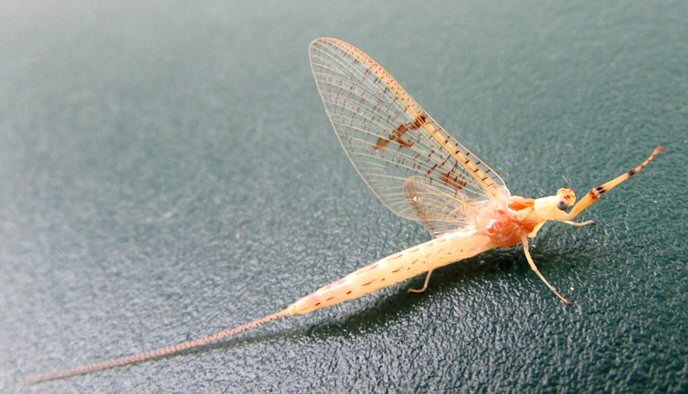 Mayfly |
Doppler Radar Captures Massive Mayfly Emergence!
The Evening of June 23, 2012
On Saturday evening, June 23 2012, a massive mayfly emergence occurred along the Mississippi River beginning just after 9 pm. By late evening, mayflies were swarming in La Crosse, La Crescent, and points up and down the river. While the emergence of mayflies from their river bottom mud dwelling can occur at various times through the warm season, this particular event was one of the best seen on radar yet. In the radar time lapse loop from 9 pm to just after 1030 pm (below), the yellows and oranges indicate a large magnitude of airborne mayflies.
Also very evident was the northward track to the mayfly radar 'echo'. This movement was due to the south wind direction over the area at emergence time. The radar would indicate the bugs were carried north, off of the river, into Blair and Taylor Wisconsin. The radar beam over these locations are detecting mayflies at over 3000 feet above the ground! Their existence was confirmed on the ground north into Trempealeau county near Galesville.
Further south along the Mississippi River, the NWS radar in Davenport, Iowa detected the emergence as well. The mayflies were seen on radar along the river from north of Davenport to about Bellevue, Illinois. Because the beam rises above the ground as it travels further from the radar, the mayflies can only be detected closer to the radar. For example, the Davenport, Iowa radar beam is at about 5000 feet above ground by the time it reaches Dubuque. While observers did note that mayflies emerged in Dubuque Saturday evening, no radar echo was seen in the area - probably because they "flew under the radar".
 |
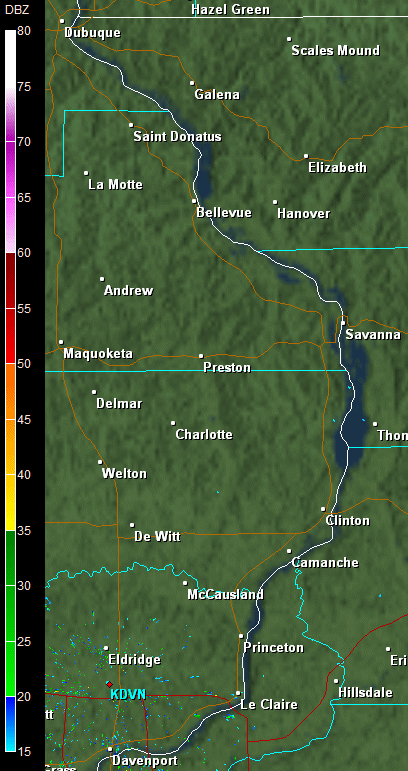 |
|
Pictures From The Following Day
|
|||||||||||||||||||||||||
On the evening of July 15, 2012, a larger mayfly emergence took place from near Red Wing, Minnesota through the Twin Cities. Parts of the Minnesota River valley also produced mayflies. This one caused problems in Hastings with plowable mayfly depths!
 |
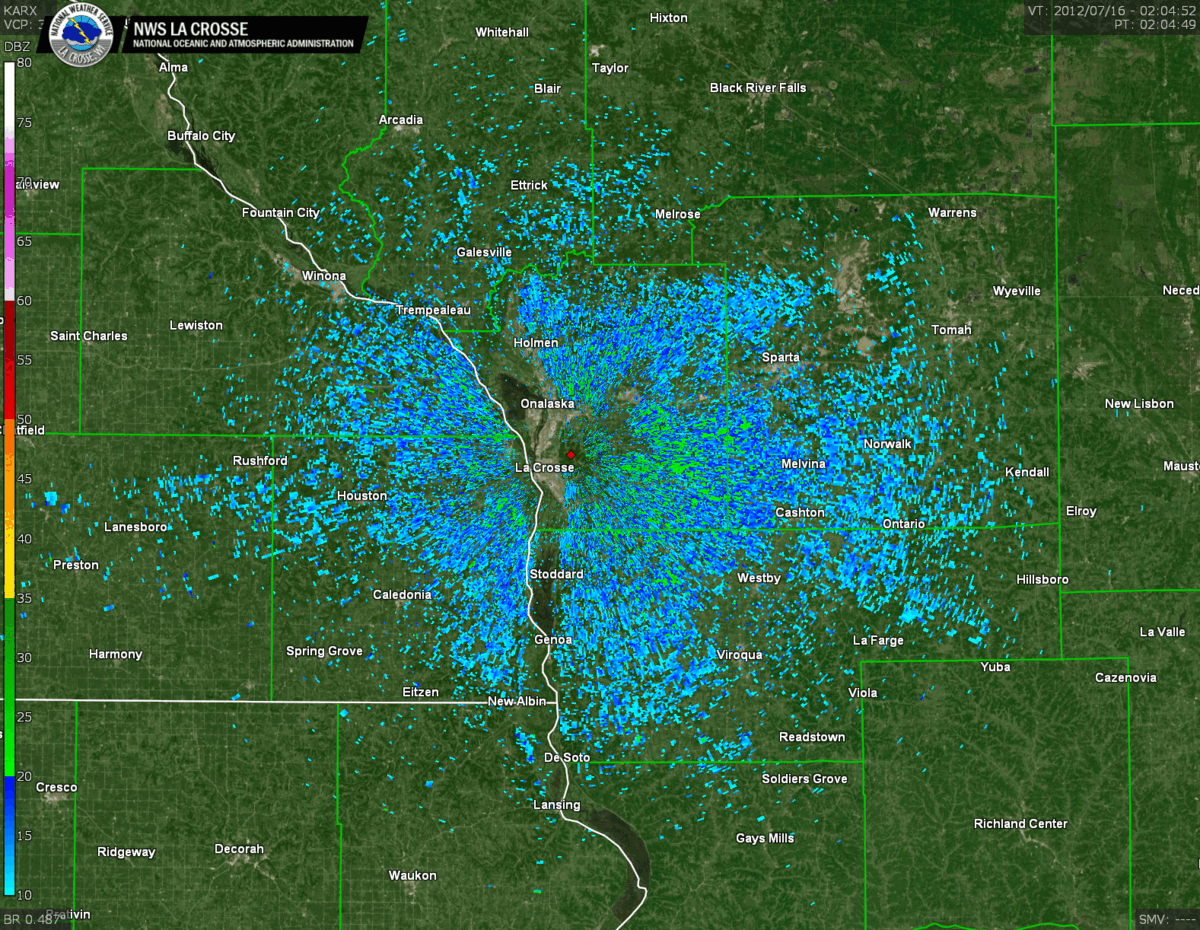 |
| July 15, 2012 Reflectivity Image (Minneapolis) | July 15, 2012 Reflectivity Loop (La Crosse) |
June 15,16, 2013
On the evening of June 15-16, 2013, mayfly activity was noted in the area. On radar, the Black River, north of La Crosse, was noticeably active with biological targets. The radar loops are from 9-1030 pm each evening. (h.limbata)
|
June 15, 2013 |
June 16, 2013 |
 |
 |
June 18, 2013
A "larger" detection was seen the evening of June 18 2013 along the Mississippi River in southwest-western Wisconsin. The interesting observation from radar was the length of time the biological echo was seen along the river (7.5 hours!) and the higher radar return (~35 dBZ). Most river biological echoes seem to last about 2 hours. This loop is from 9pm June 18 - 430am June 19. Ground truth was seen in downtown La Crosse during this June 15-18 period in the form of h.limbata mayflies.
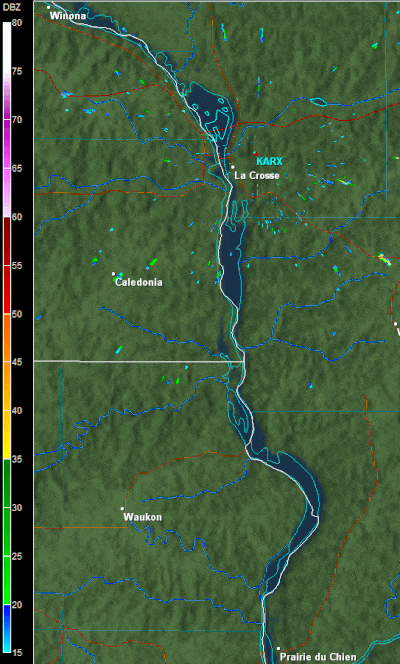 |
June 25,26 2013
Surface observers on June 25 reported a "moderate" emergence on the Mississippi River, pool 16, near Davenport, Iowa. Radar data seemed a bit more active further north up the Mississippi River, and relatively light near the radar along the river. There is much to see in these loops, including showers and thunderstorms to the north-northwest. Concentrate on the river itself to see the biological echo. These loops are from 9-11 pm each night.
|
June 25, 2013 |
June 26, 2013 |
 |
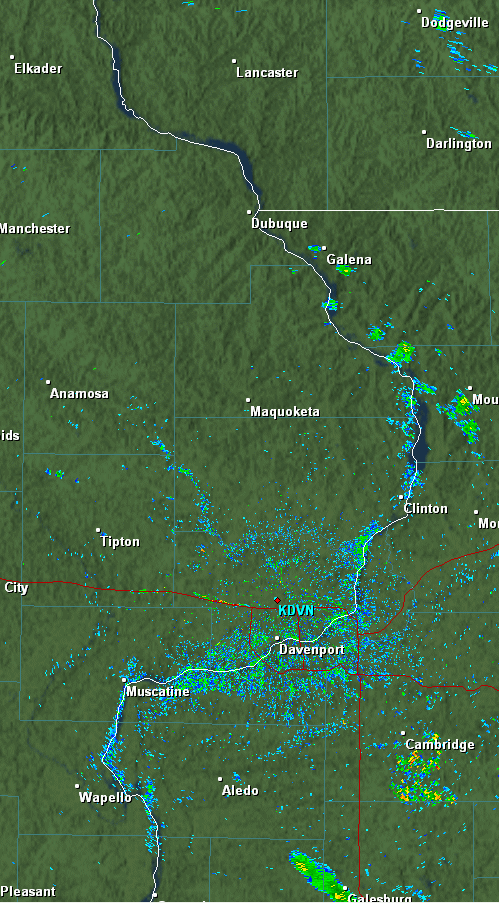 |
July 14,2013
A warm, muggy evening prevailed as a noticeable mayfly emergence appeared on the La Crosse, WI radar. This radar loop goes from around 9 until 11 pm. It suggests that the emergence was intially higher south of La Crosse and then spread northward, as the prevailing wind flow was out of the south and east. The image on the right shows a cluster of mayflies as captured by WKBT Meteorologist Bill Graul.
On an evening very similar to the massive mayfly event of June 23 2012, the Mississippi River produced a massive radar echo as mayflies emerged from the water and became airborne. The mayflies were detectable on radar around 845 pm and reports in the towns and cities began rolling in of the swarming and piles of mayflies. Numerous videos and pictures were circulating on social media, some of which are posted below as well.
The radar detected the flies about 845 pm, emanating from the river (the source) with echo values similar to that of light-moderate rain (35-40 dBZ). With a general south-to-north wind flow above the surface, the mayflies quickly moved north once in the air. As the flies dispersed moving north-northeast, they also gained altitude with some of the echo being detected as far north as Black River Falls and as high as 2500 feet above ground.
By late evening, mayflies were swarming in La Crosse, La Crescent, Stoddard and points up and down the river. While the emergence of mayflies from their river bottom mud dwelling can occur at various times through the warm season depending on the species, this particular emergence was that of the larger black/brown Bilineata species. The radar loop below shows the reflected radar energy (reflectivity) from 835 pm to just after midnight. The higher the values (greens to yellows) indicate greater concentrations of flies. Note how the swarm is carried northward over time.
|
Radar Images at 954 pm July 24, 2014 |
||
 |
 |
|
| Black background | Terrain background | Mississippi River shown with black arrows. States shown. |
Minor Mayfly Emergence
The Evening of July 24, 2014
Four nights after the massive emergence of mayflies along the Mississippi River near La Crosse, a minor mayfly emergence was seen on radar. This was verified by a ground report near Onalaska of many seen flying the following morning (Friday). The radar loop below is from 845pm to 1111pm July 24, 2014.
 |
Large Mayfly Emergence
The Evening of July 4, 2015
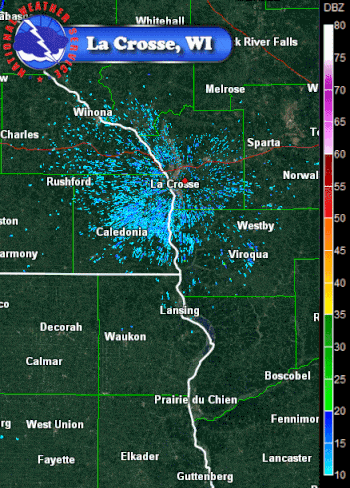
 |
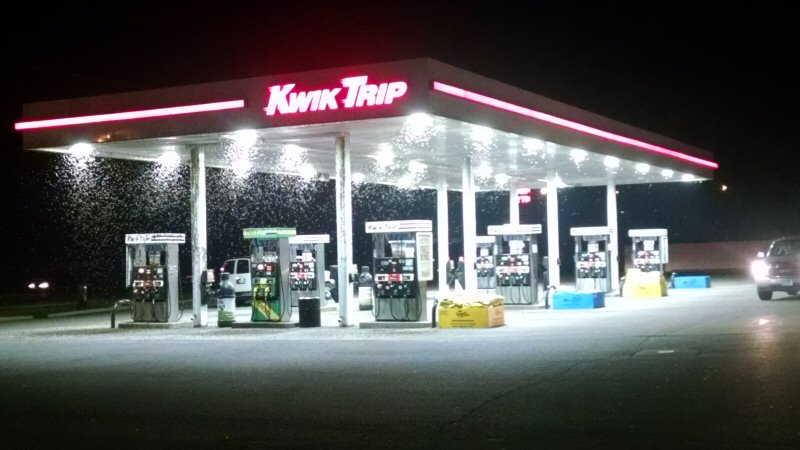 |
 |
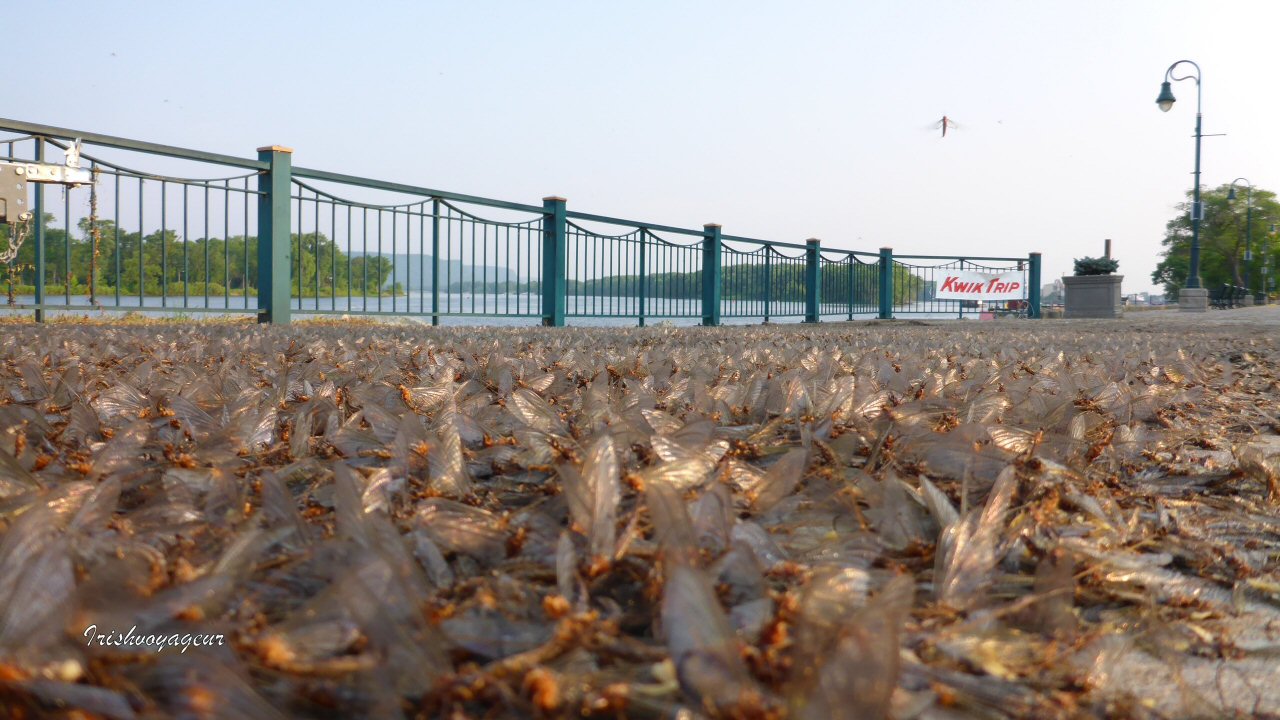 |
| On 3rd St, south of downtown La Crosse, WI. (Courtesy Dan Baumgardt) |
Free mayflies with every fill-up! Kwik Trip southside La Crosse, WI. |
Mayfly blizzard? Dairy Queen southside La Crosse, WI. (Courtesy Dan Baumgardt) |
Aftermath: Riverside Park, La Crosse, WI, July 5 2015.(Courtesy John Sullivan)
|
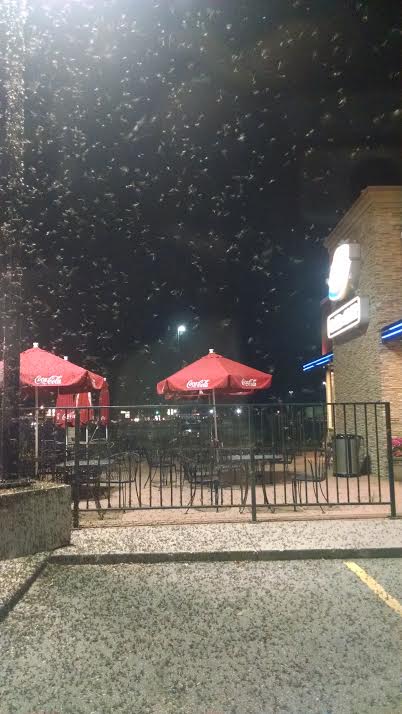 |
 |
||
| Dairy Queen southside La Crosse, WI. (Courtesy Dan Baumgardt) |
Aftermath: Riverside Park, La Crosse, WI, July 5 2015. (Courtesy John Sullivan) |
Light Mayfly Emergence
The Evening of July 23, 2015

Minor Mayfly Emergence
The Evening of July 8, 2016
On the evening of July 8, 2016, a minor mayfly emergence was noted on radar just after 9 pm. The mayfly swarming lasted through about 10:30 pm on radar.

Light Mayfly Emergence
The Evening of July 26, 2016
On the evening of July 26, 2016, a light mayfly emergence was noted on radar just after 9 pm. The mayfly swarming lasted through about 10:30 pm on radar.
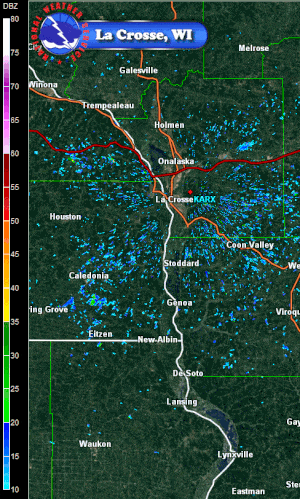
 |
| At the NWS Office just east of La Crosse. (Courtesy Dan Baumgardt) |
Light to Moderate Mayfly Emergence
The Evening of July 27, 2016
On the evening of July 27, 2016, a light mayfly emergence was noted on radar around 9 pm. Something notable with this emergence was an outflow boundary from earlier storms that forced a portion of the swarm to move south. An outflow boundary is the leading edge of a cool pool of air ejected from a storm. This is annotated on the second radar animation below. The radar was able to detect swarms as far north as Wabasha, MN to as far south as Lynxville, WI. Swarms were also seen in Lake City, MN, though it is difficult to determine if the radar returns in that area were due to the mayflies or showers in the area. The mayfly emergence in Lake City was more of a moderate to heavy emergence on the Johnson Mayfly Emergence Scale.
 |
 |
| Radar loop from approximately 8:45 pm to 10:45 pm. | Outflow boundary forcing mayfly swarm south. |
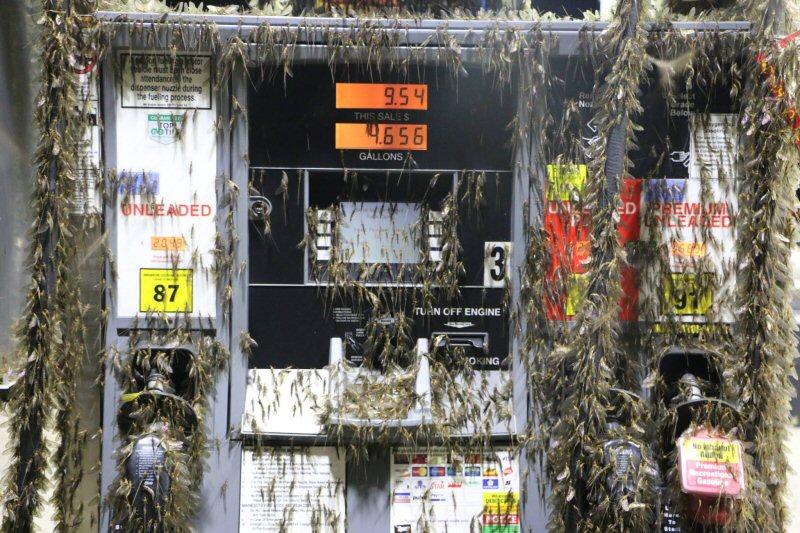 |
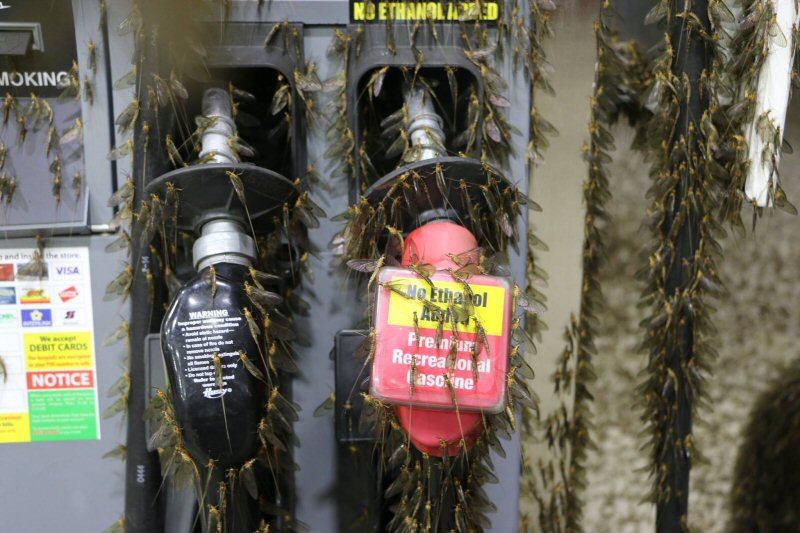 |
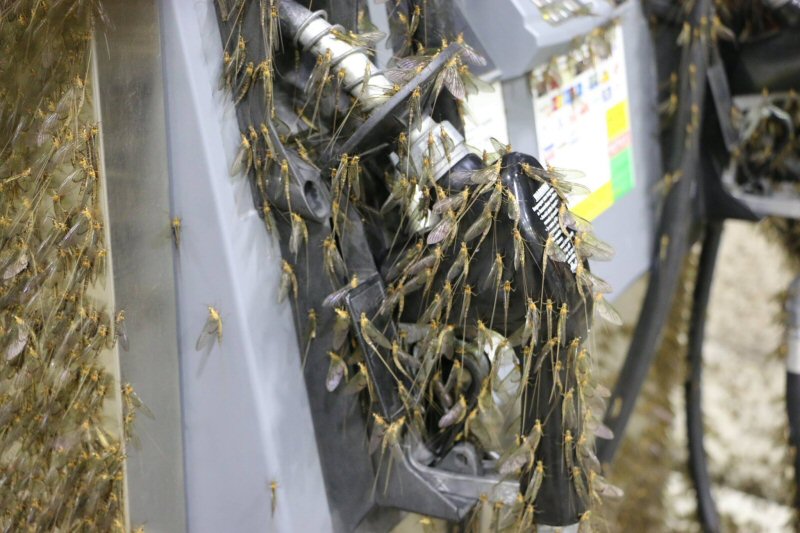 |
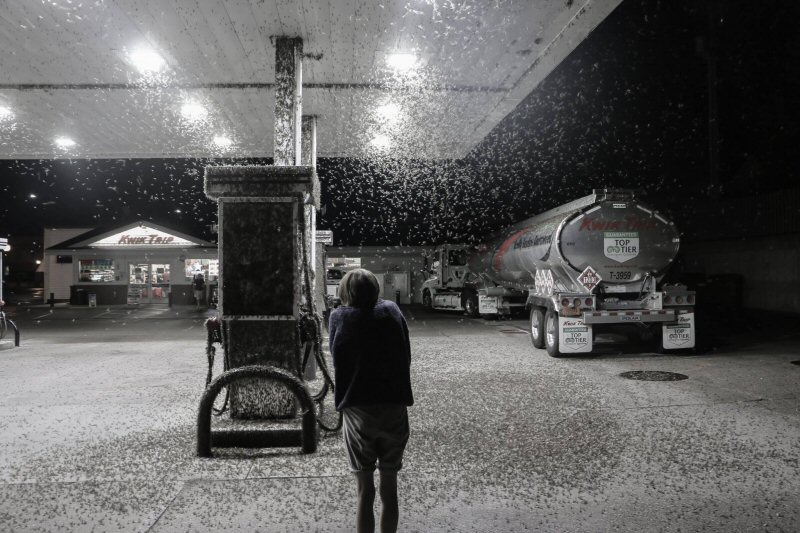 |
 |
 |
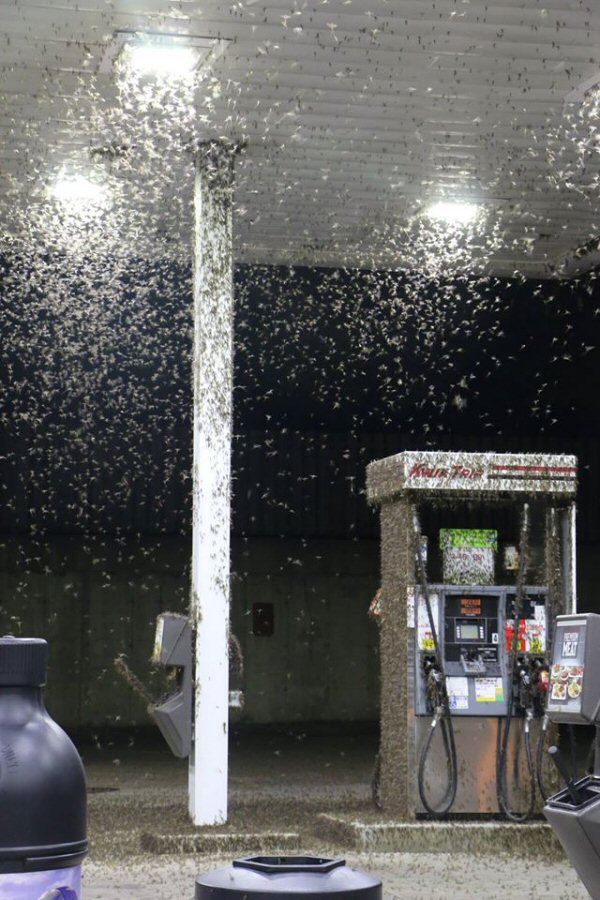 |
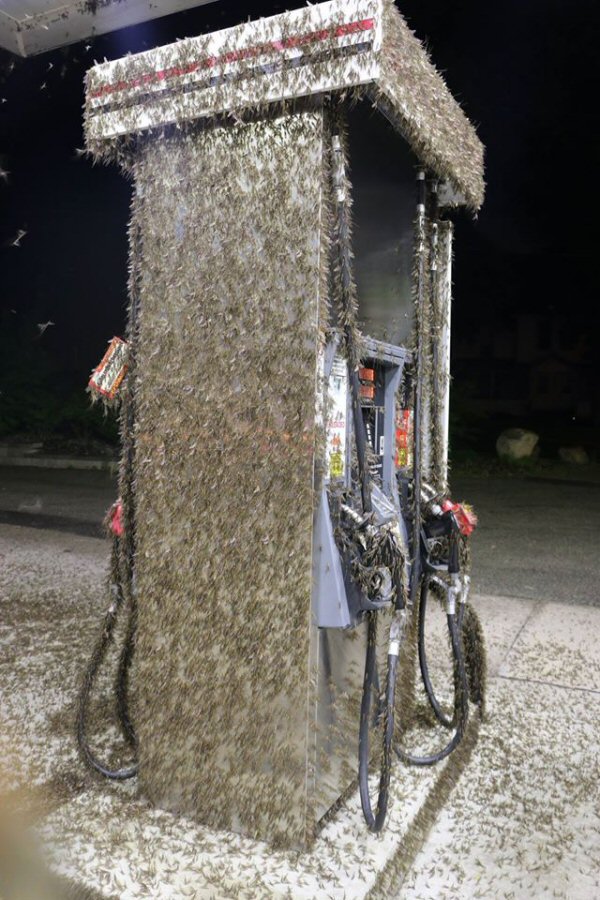 |
 |
| Mayfly swarms in Lake City, MN (All photos courtesy of Manda Hart Baldwin) |
Light Mayfly Emergence
The Evening of July 30, 2016
On the evening of July 30, 2016, a light mayfly emergence was noted on radar beginning just before 9 pm near Stoddard, WI. Swarming was detected from Fountain City, WI, to Lynxville, WI. The mayfly swarming lasted through about 10:30 pm on radar.
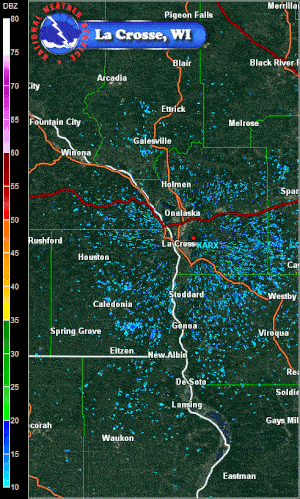
Large Mayfly Emergence
The Evening of July 11, 2017

 |
 |
 |
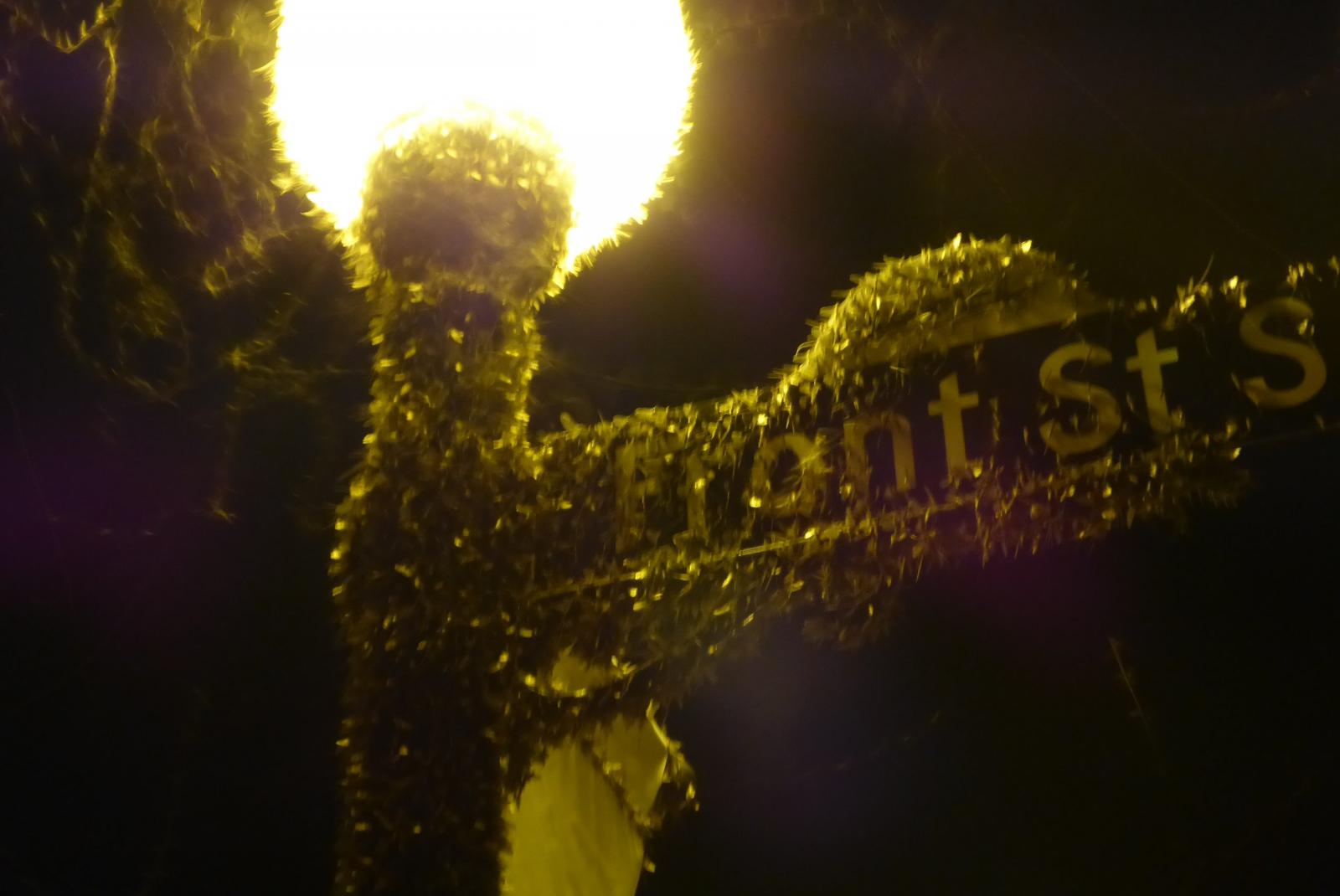 |
 |
| Mayfly swarms in La Crosse, Wisconsin (All photos courtesy of John Sullivan) |
Slight Mayfly Emergence
The Evening of July 8, 2018

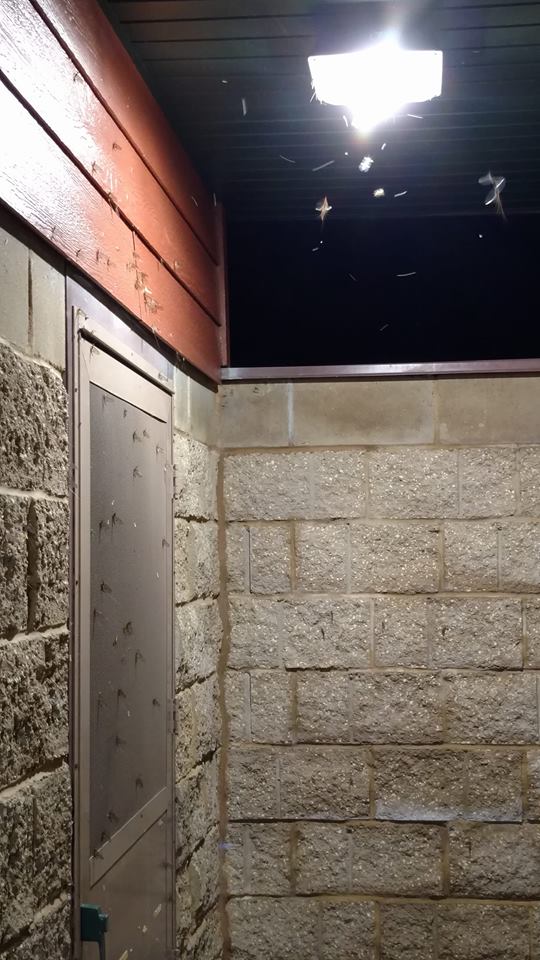 |
 |
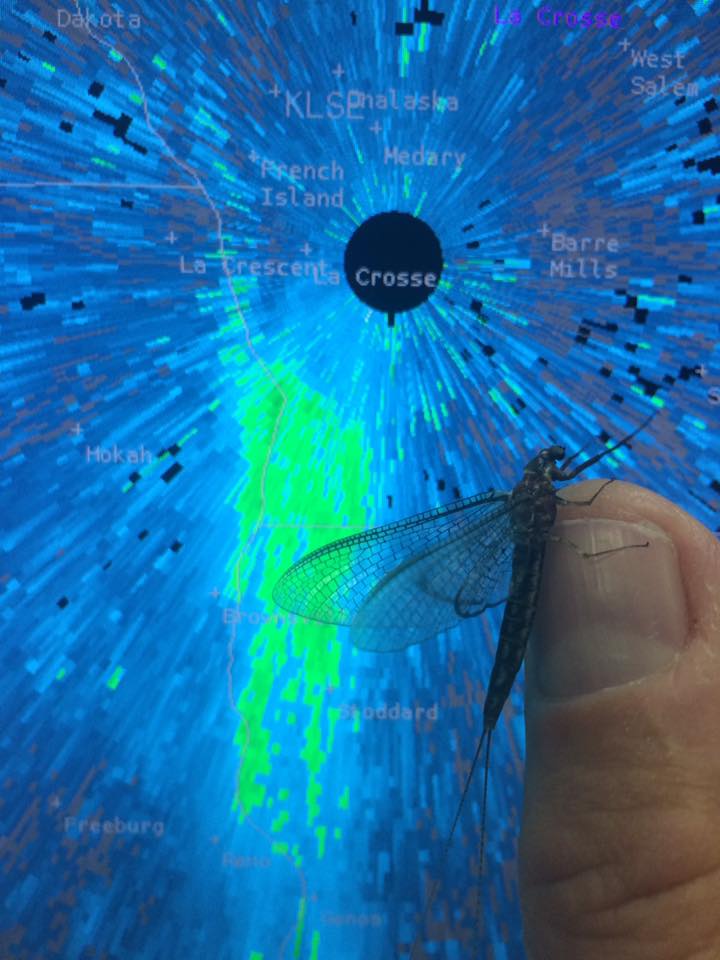 |
| Near Goose Island, south of La Crosse, WI (Courtesy Todd Rastall) |
Near Goose Island, south of La Crosse, WI (Courtesy Todd Rastall) |
Mayfly (Bilineata) at the NWS La Crosse office (NWS) |
Slight to Light Mayfly Emergence
The Evening of July 23, 2018

 |
| Specimen Mayfly (Limbata) Seen on Losey Blvd, La Crosse, WI (Courtesy Dan Baumgardt) |
Light to Moderate Mayfly Emergence
The Evening of July 24, 2018

 |
 |
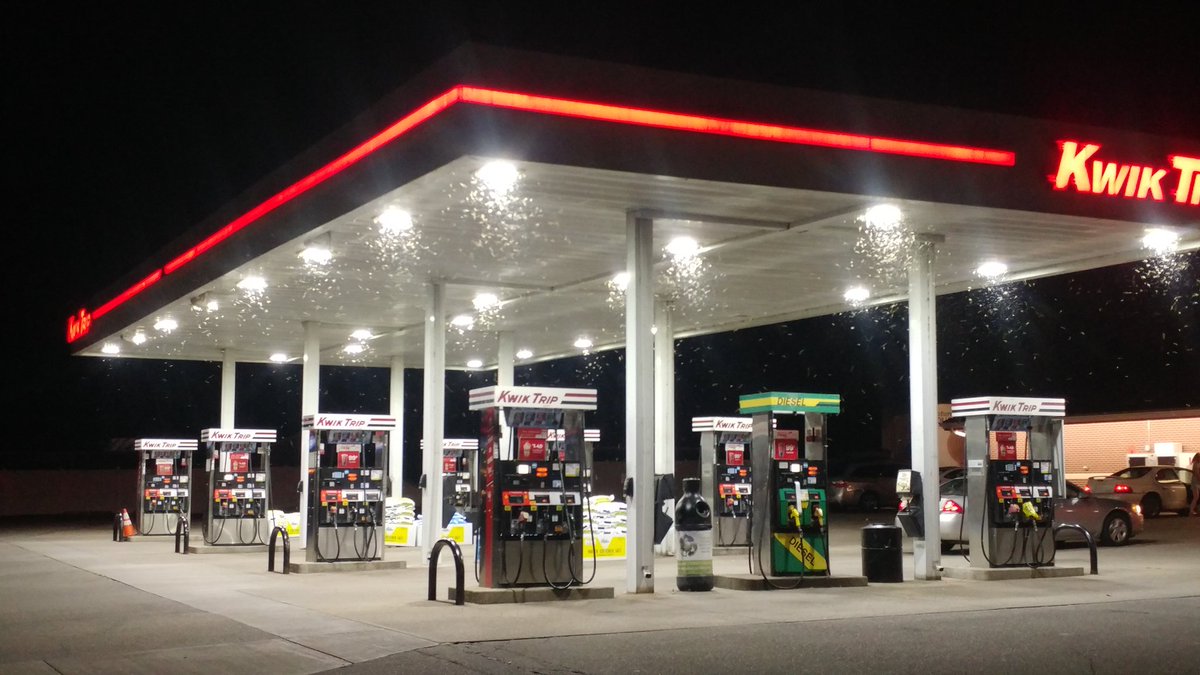 |
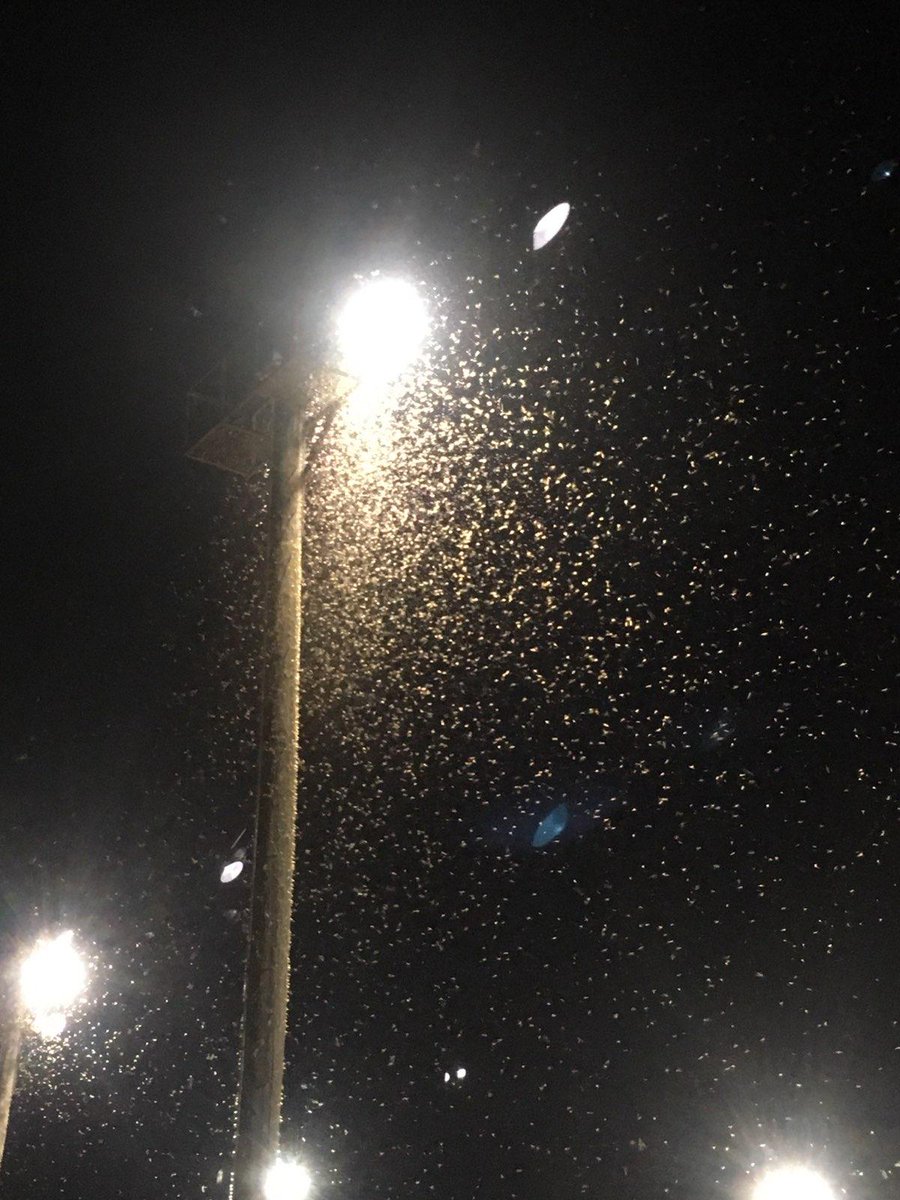 |
| Video of swarming: 945 pm. South side of La Crosse, WI (Courtesy Dan Baumgardt) |
Specimen Mayfly: Limbata. South side of La Crosse, WI (Courtesy Dan Baumgardt) |
Swarming image: 945 pm, South side of La Crosse, WI (Courtesy Dan Baumgardt) |
Swarming near Erickson Park: 9 pm, La Crosse, WI (Courtesy Sawyer Baumgardt) |
Moderate Mayfly Emergence
The Evening of July 28, 2018

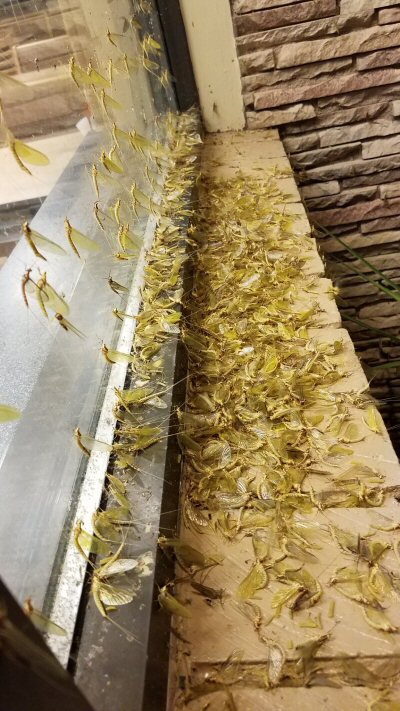 |
 |
 |
| South La Crosse, WI (Courtesy Jack Richter) |
South La Crosse, WI |
Mayflies swarming in south La Crosse, WI |
Light Mayfly Emergences
July 26 & 27, 2019
 |
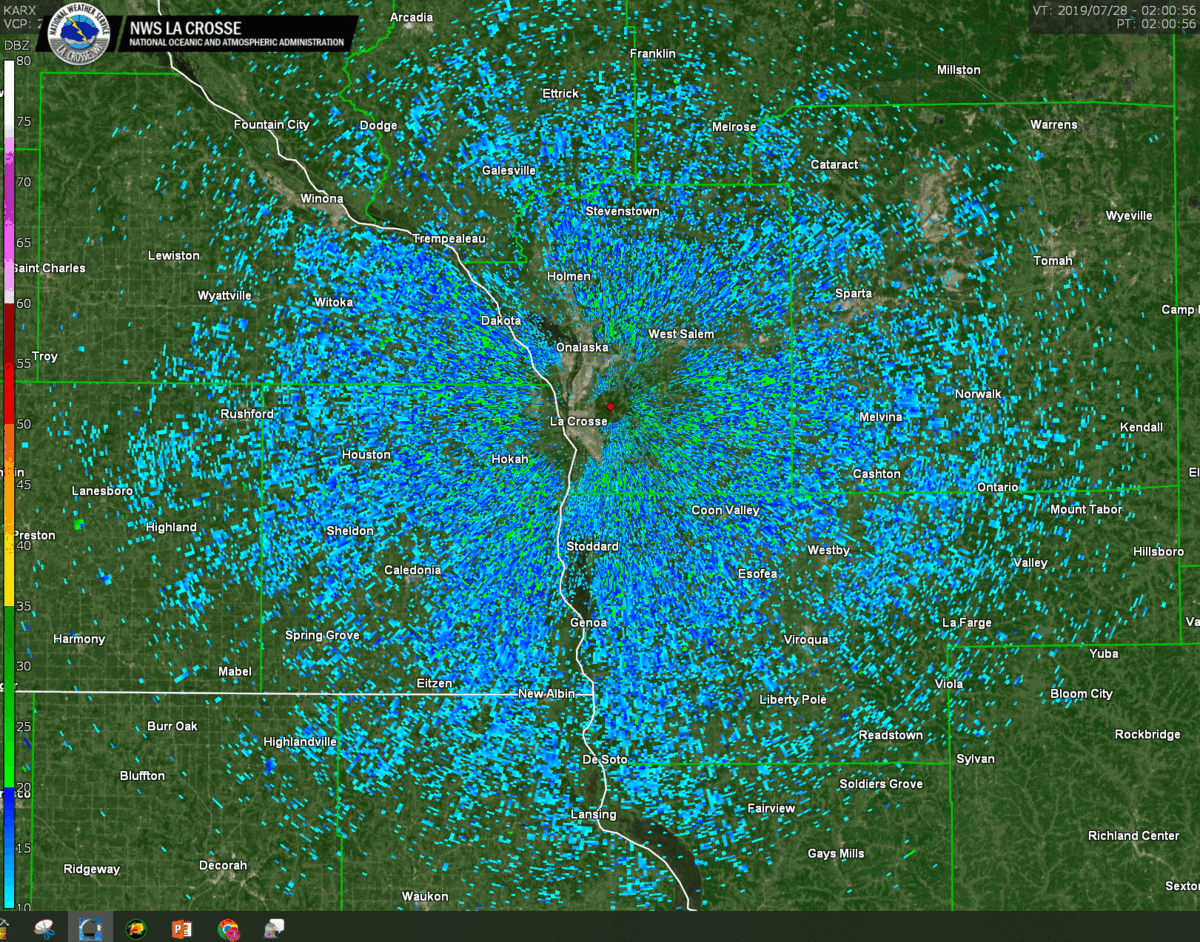 |
| July 26, 2019 | July 27, 2019 |
 |
 |
|
| Enjoying the game with extra Mayfly eyes (Credit: Dan Baumgardt) |
Mayfly takes the wheel (Credit: Dan Baumgardt) |
 |
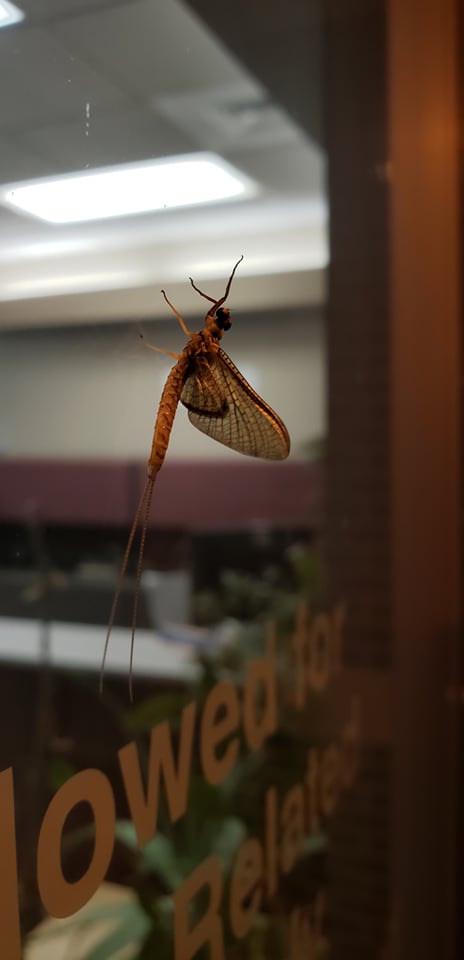 |
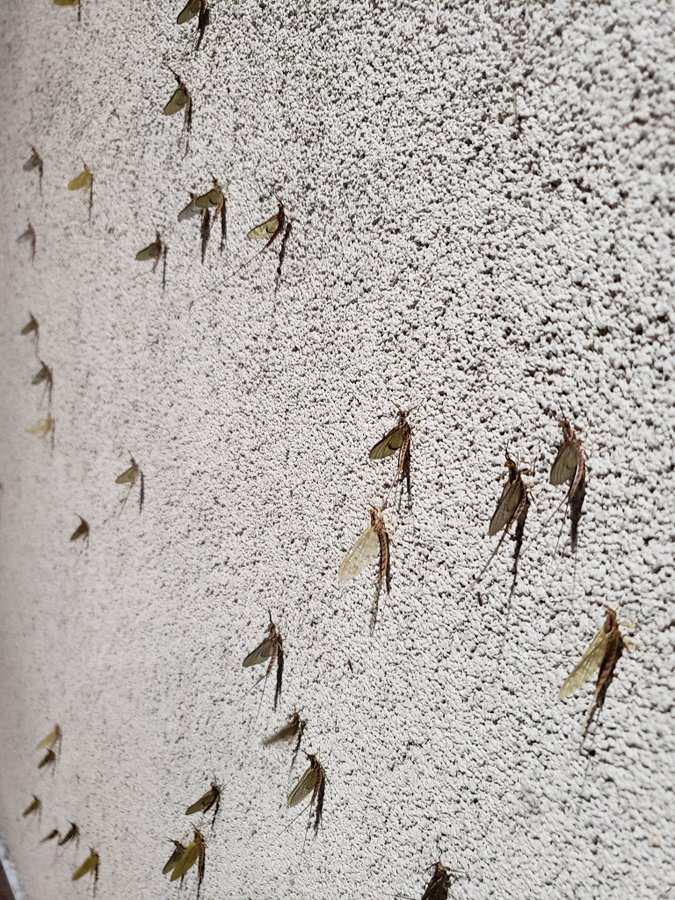 |
|
| Mayfly on brick (Credit: Dave Lawrence) |
Mayfly on glass (Credit: Dave Lawrence) |
Mayfly on concrete (Credit: Todd Shea) |
Light Mayfly Emergences
August 1 & 3, 2019
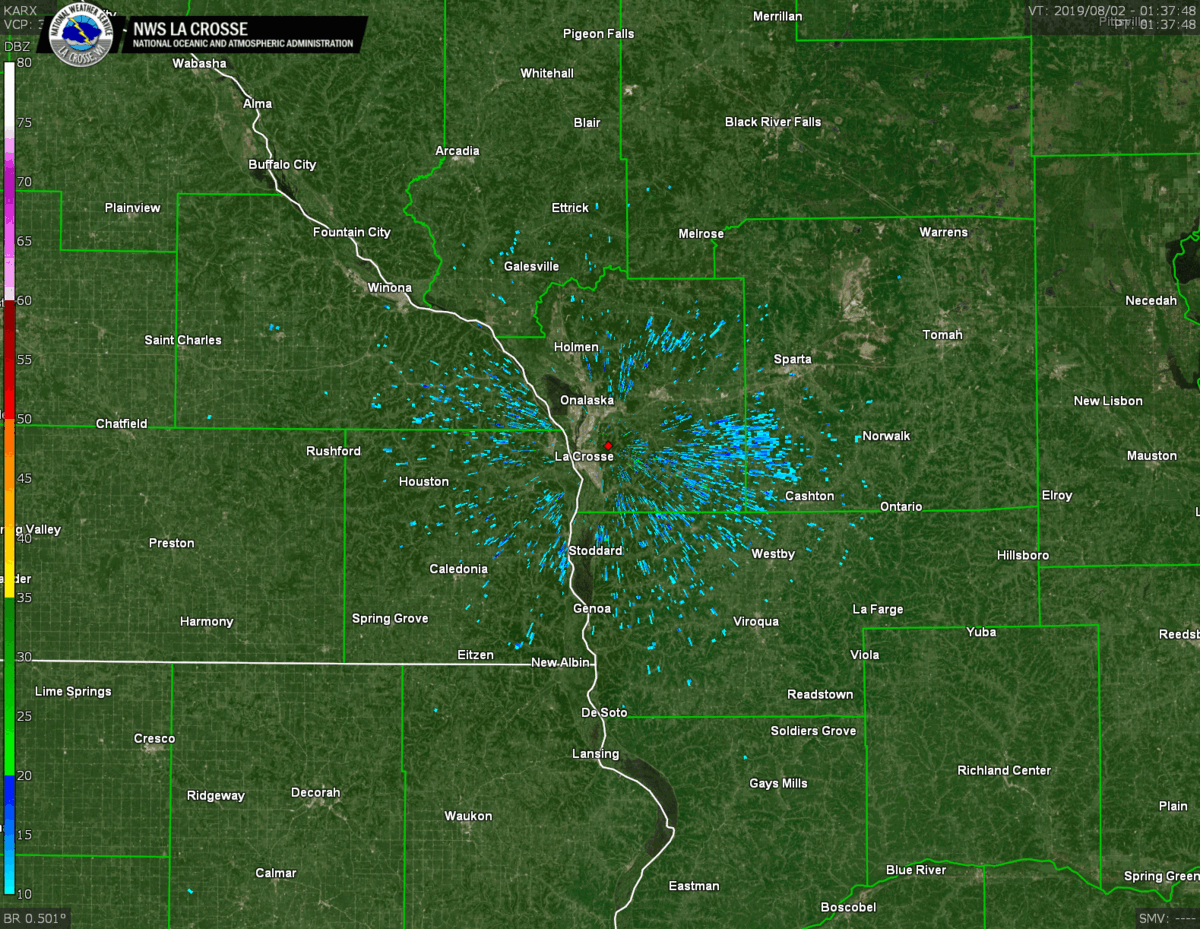 |
 |
| August 1, 2019 | August 3, 2019 |
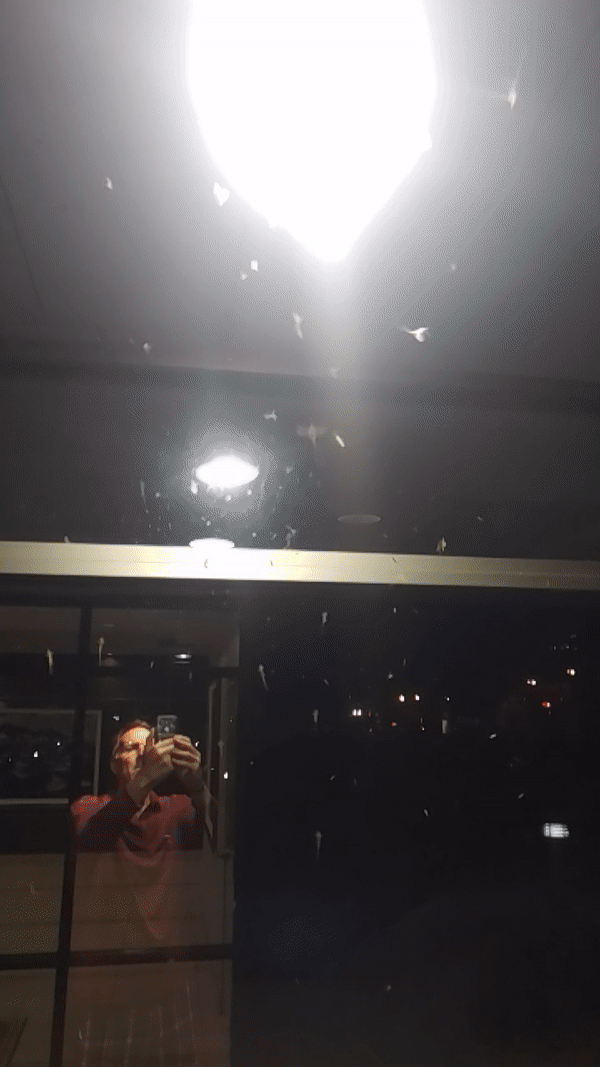 |
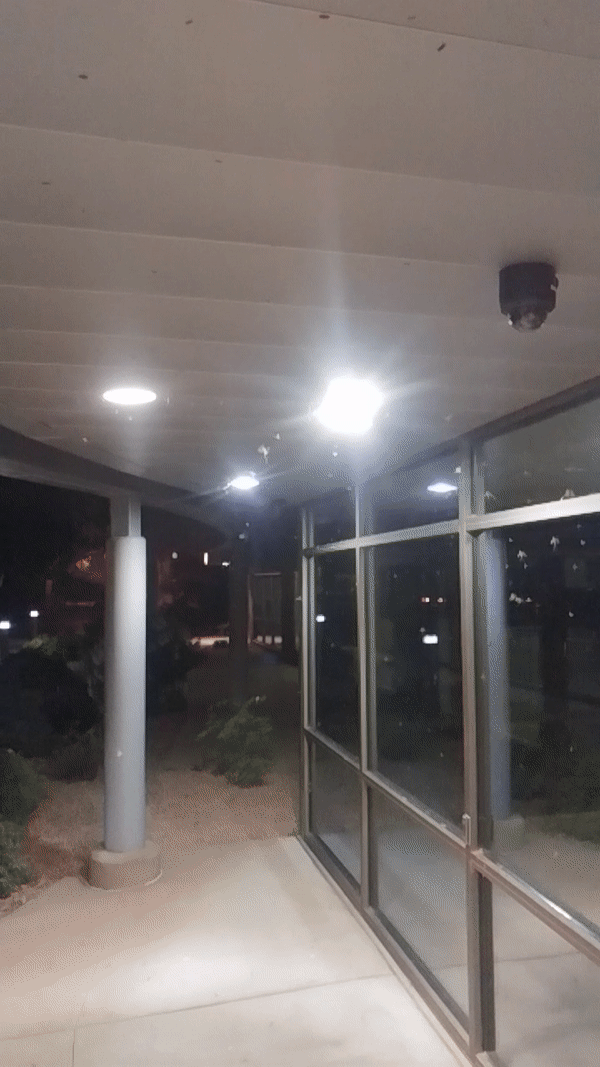 |
 |
|
| August 1 light Swarm (Credit: Dan Baumgardt) |
August 1 light Swarm (Credit: Dan Baumgardt) |
August 3 light Swarm (Credit: Dan Baumgardt) |
 |
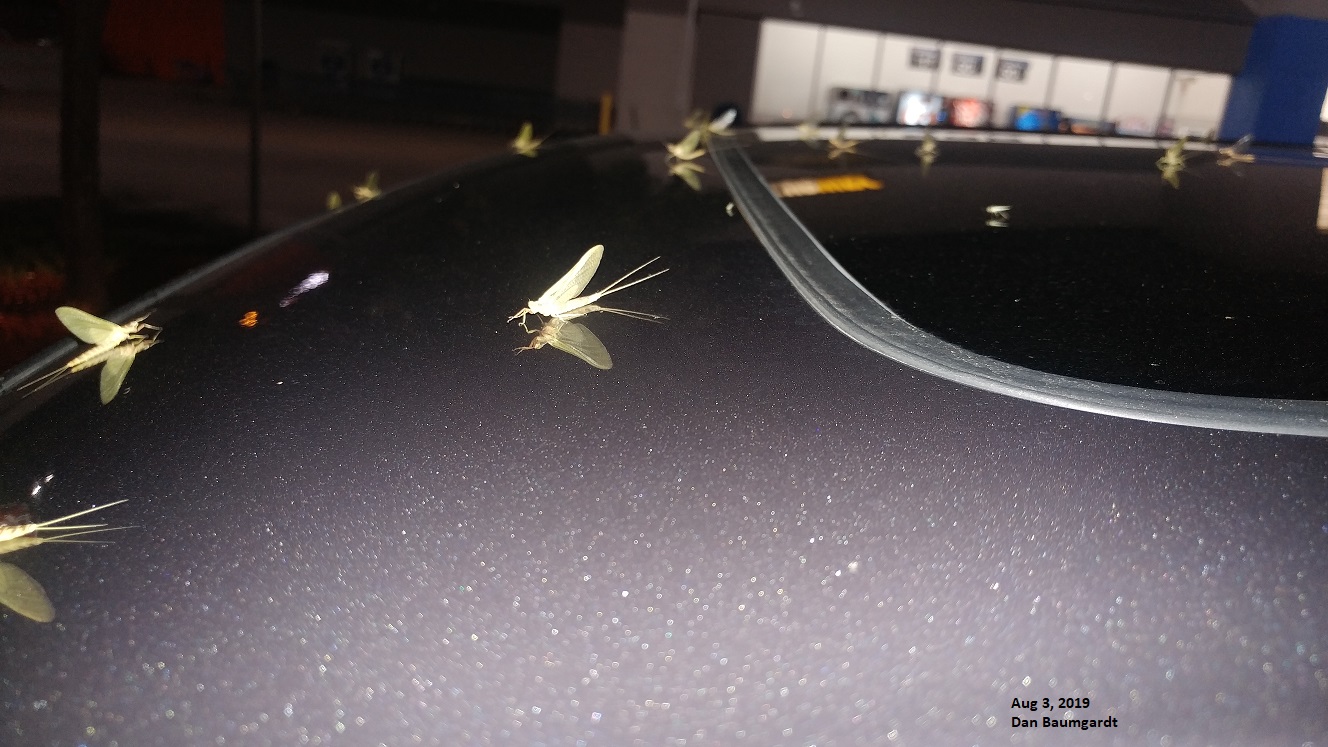 |
 |
Light Mayfly Emergence
The Evenings of June 6-8, 2020
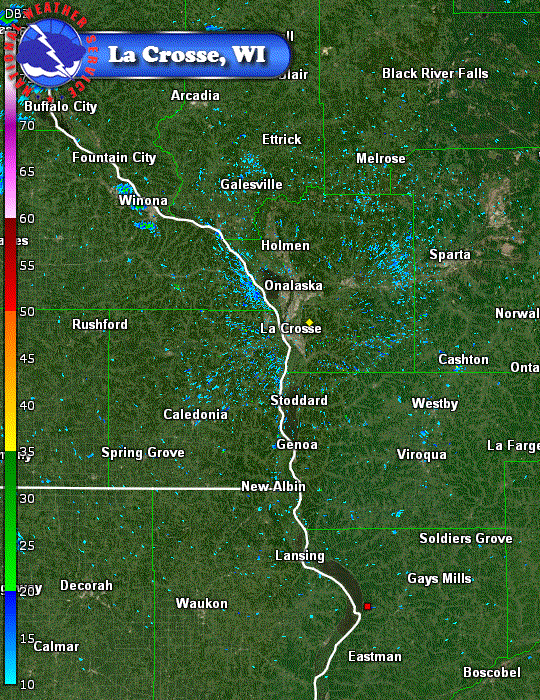 |
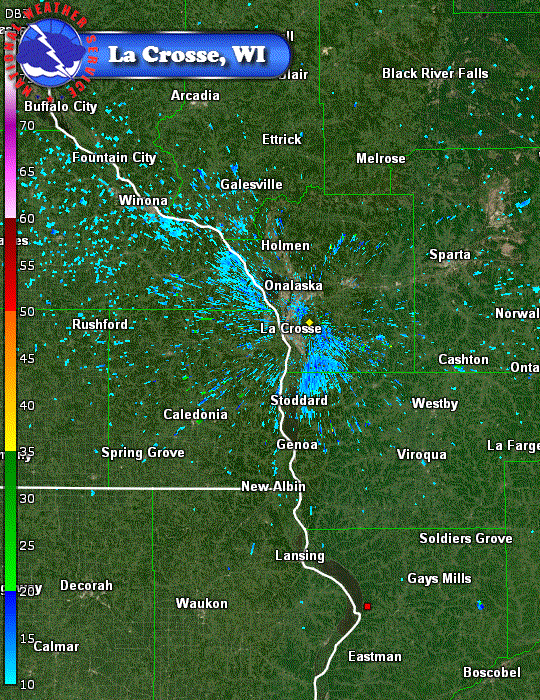 |
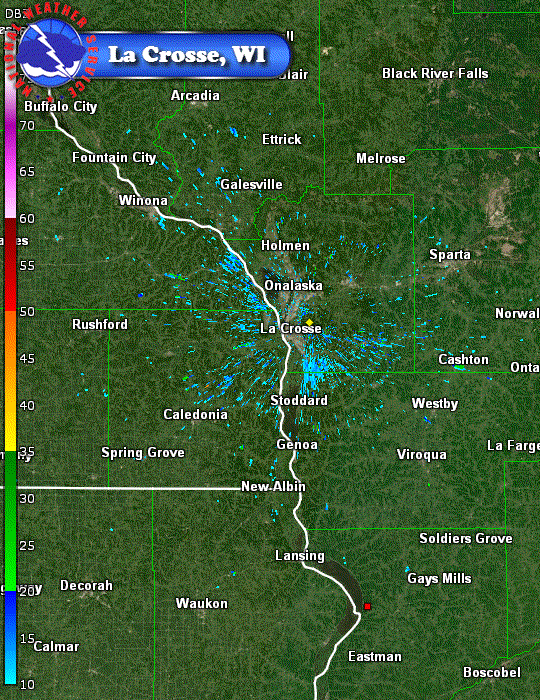 |
| June 6, 2020 | June 7, 2020 | June 8, 2020 |
Series of Light Mayfly Emergences
June 11-14, 2022
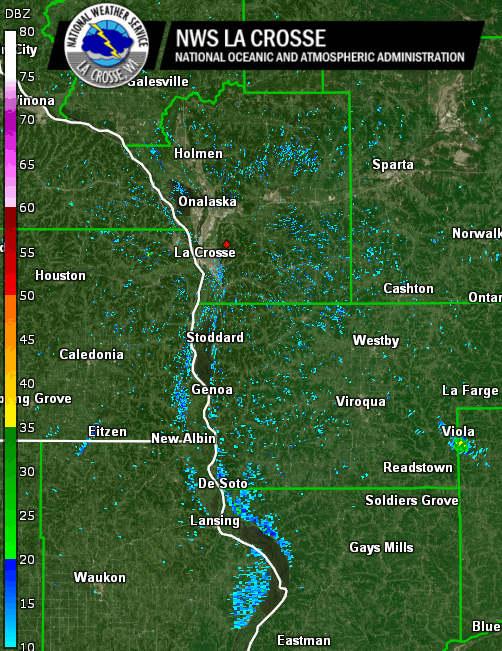 |
| Radar Imagery(La Crosse) (June 11, 2022; 8:10pm-10:35pm) |
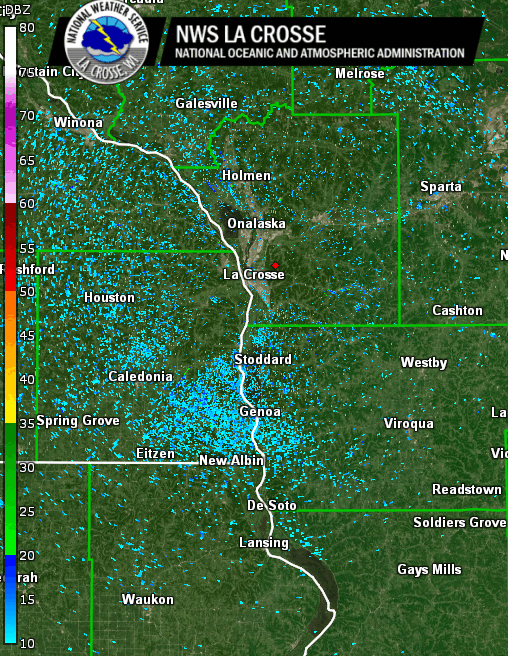 |
| Radar Imagery(La Crosse) (June 12, 2022; 8:49pm-10:36pm) |
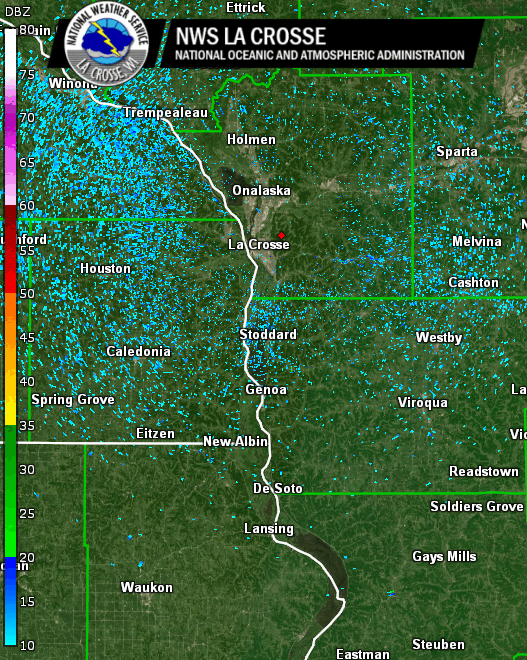 |
| Radar Imagery(La Crosse) (June 13, 2022; 8:48pm-10:17pm) |
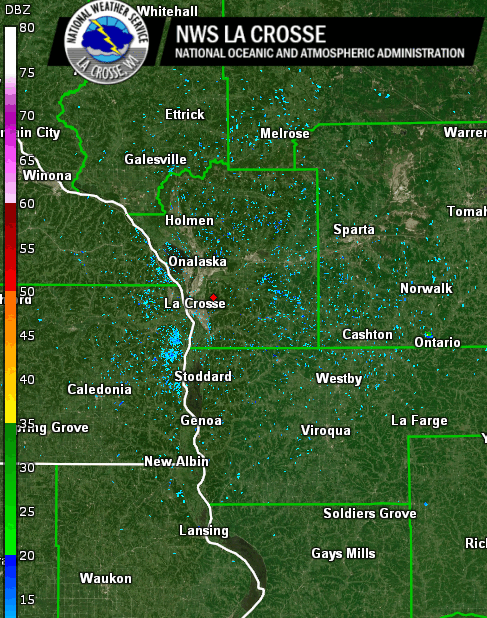 |
| Radar Imagery(La Crosse) (June 14, 2022; 9:04pm-10:04pm) |
Moderate Mayfly Emergence
July 7, 2022
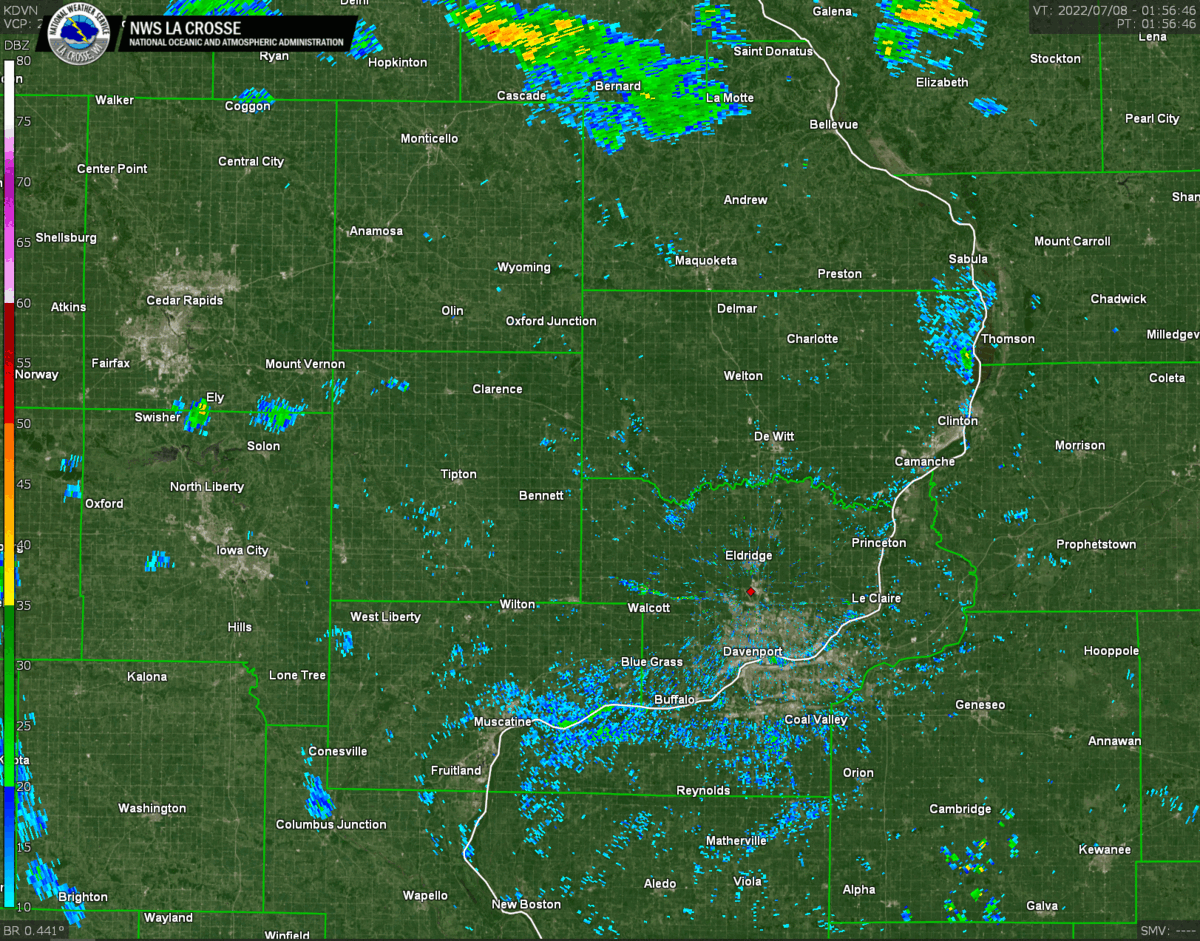 |
 |
| July 7, 2022 Reflectivity (Davenport) | July 7, 2022 Reflectivity (La Crosse) |
 |
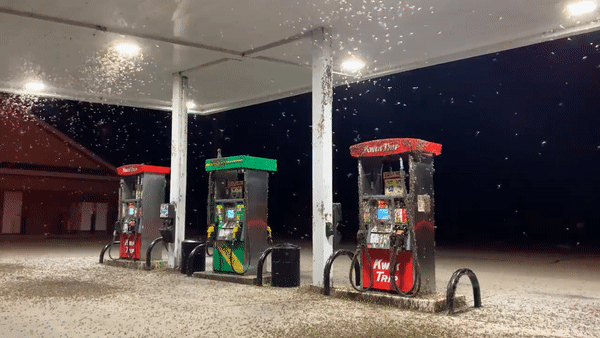 |
|
| Blackhawk Ave, Prarie Du Chien, WI (Credit: Clarissa via Twitter) |
Gas Station Swarm (Credit: Miller Hyatt via Twitter) |
Moderate Mayfly Emergence
July 26, 2022
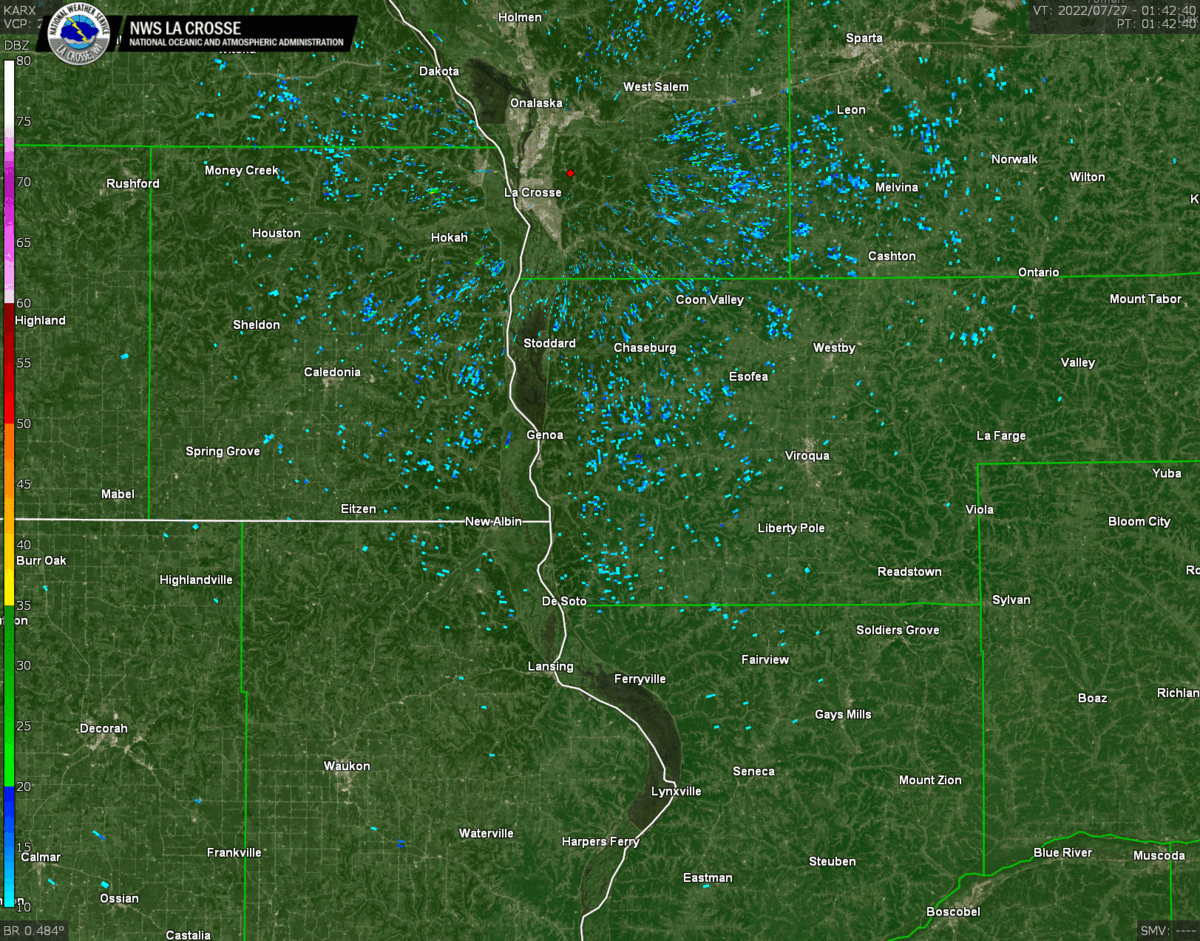 |
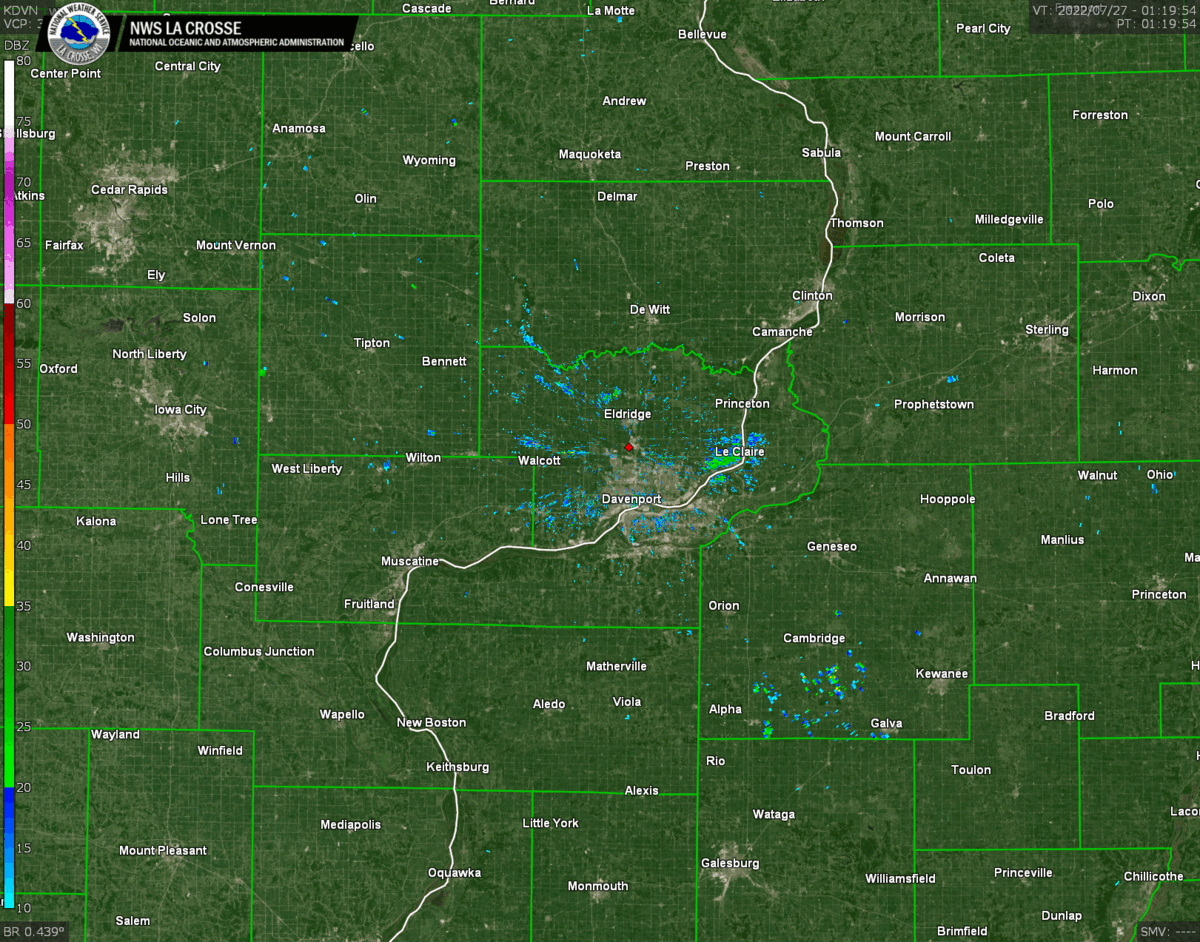 |
| July 26, 2022 Reflectivity (La Crosse) | July 26, 2022 Reflectivity (Davenport) |
 |
| Gas Station Swarm (Credit: Miller Hyatt via Twitter) |
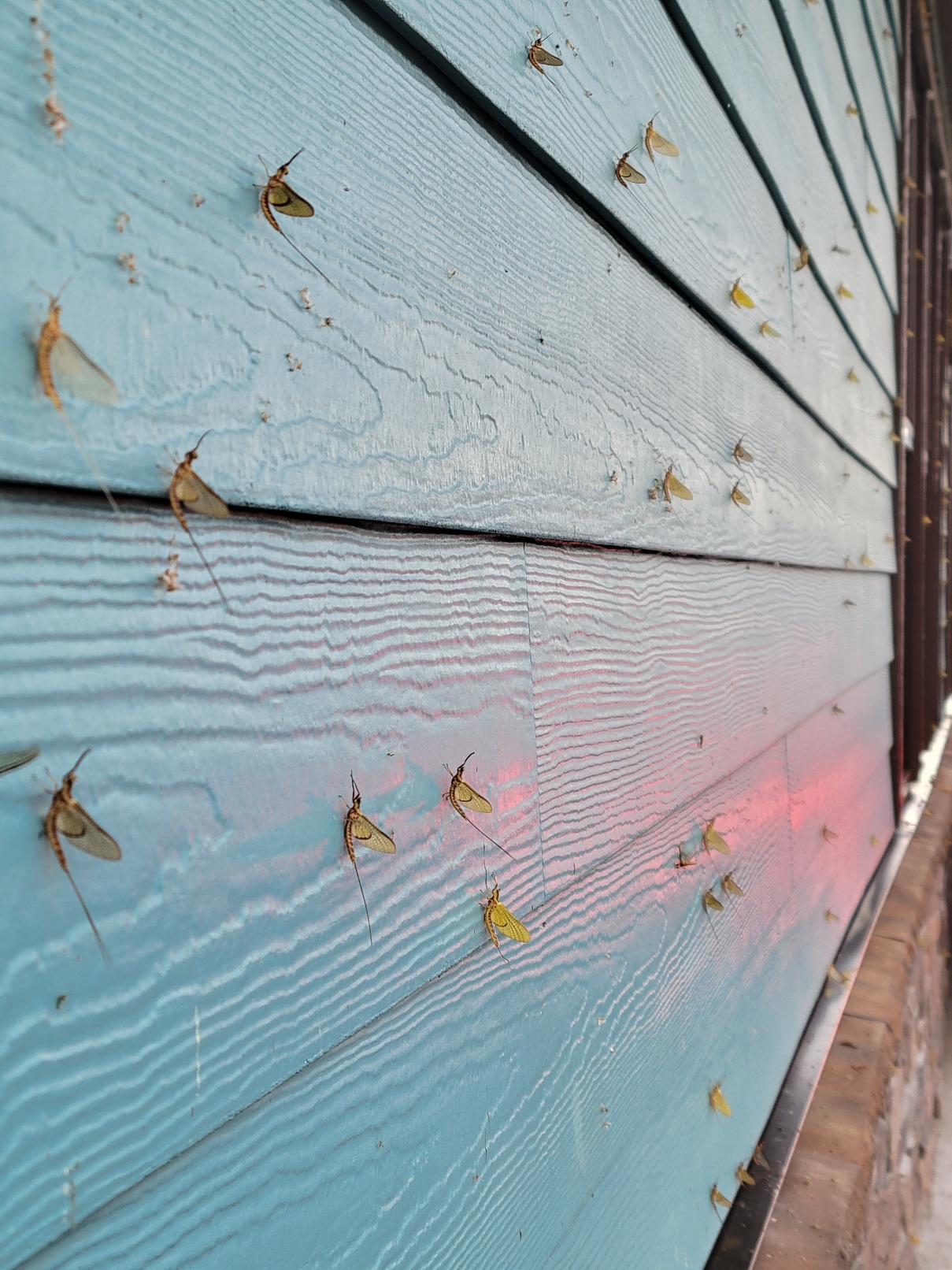 |
|
| Mayflies on building, South La Crosse (Credit: Dan Baumgardt) |
Light-Moderate Mayfly Emergence
August 18, 2022
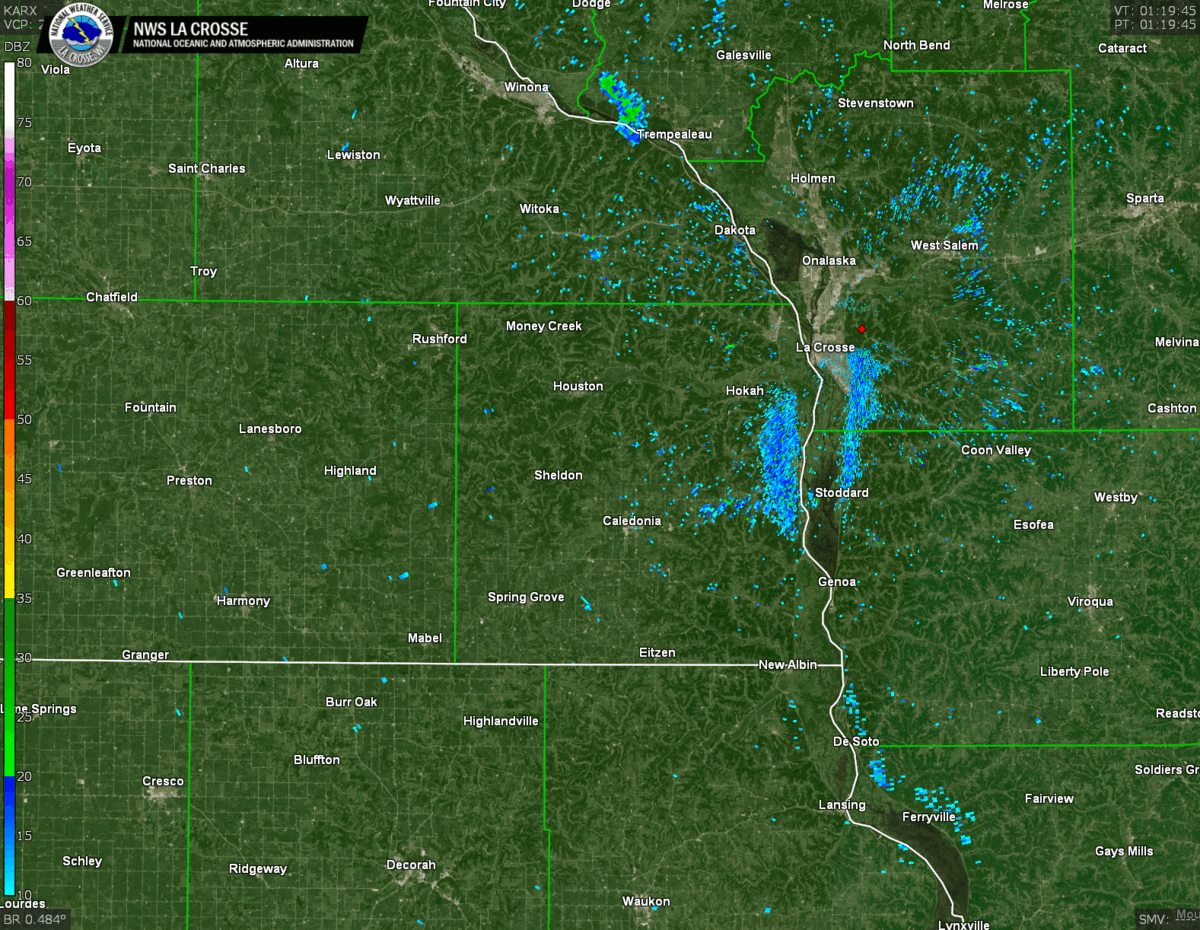 |
| August 18, 2022 Reflectivity (La Crosse) |
 |
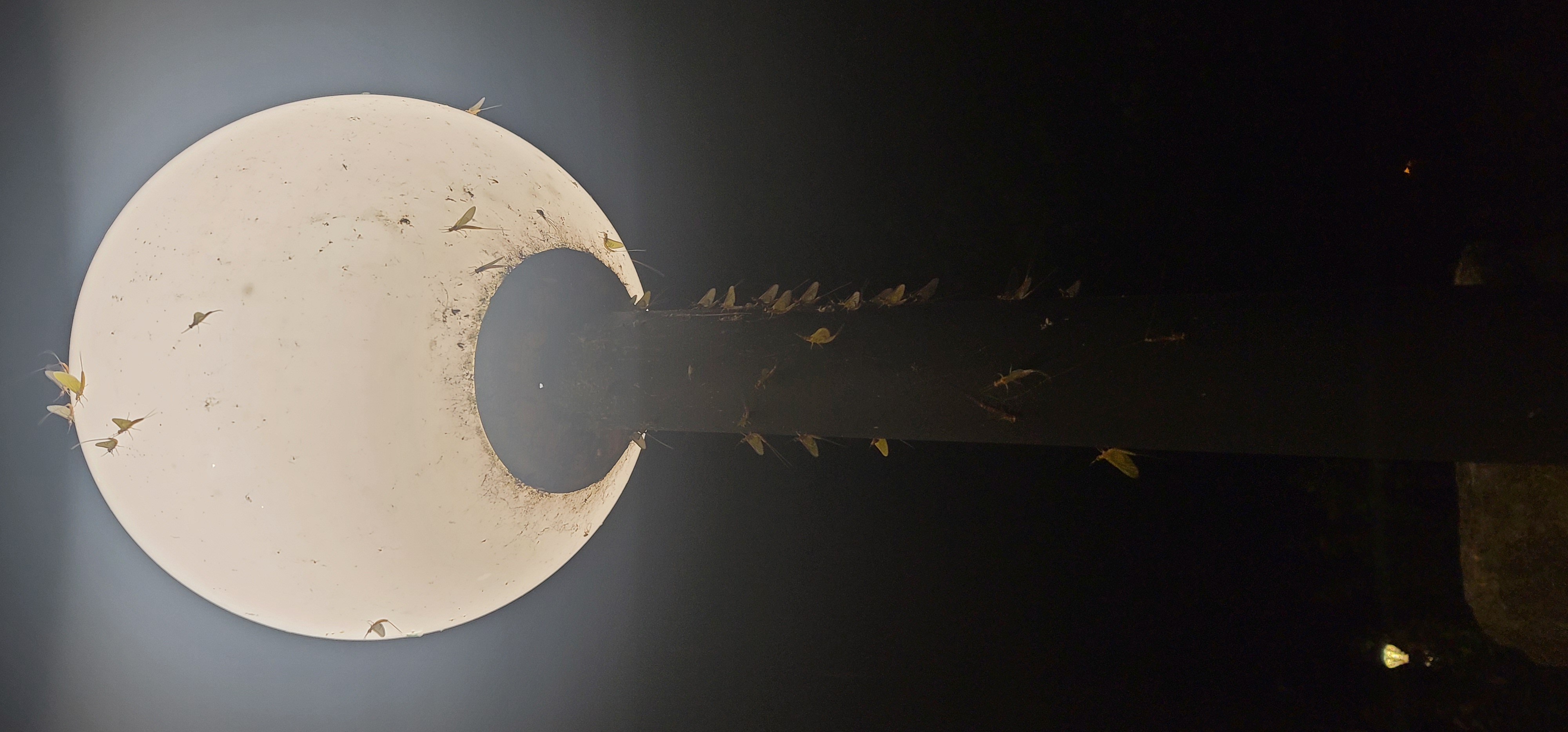 |
|
| South La Crosse, WI (Credit: Joseph Ricciotti) |
South La Crosse, WI (Credit: Joseph Ricciotti) |
Series of Light To Moderate Emergences
June 1-8, 2023
The first week of meteorological summer provided light to moderate emergences along the Upper Mississippi River Valley. A strong start to bug season and a great way to start the summer!
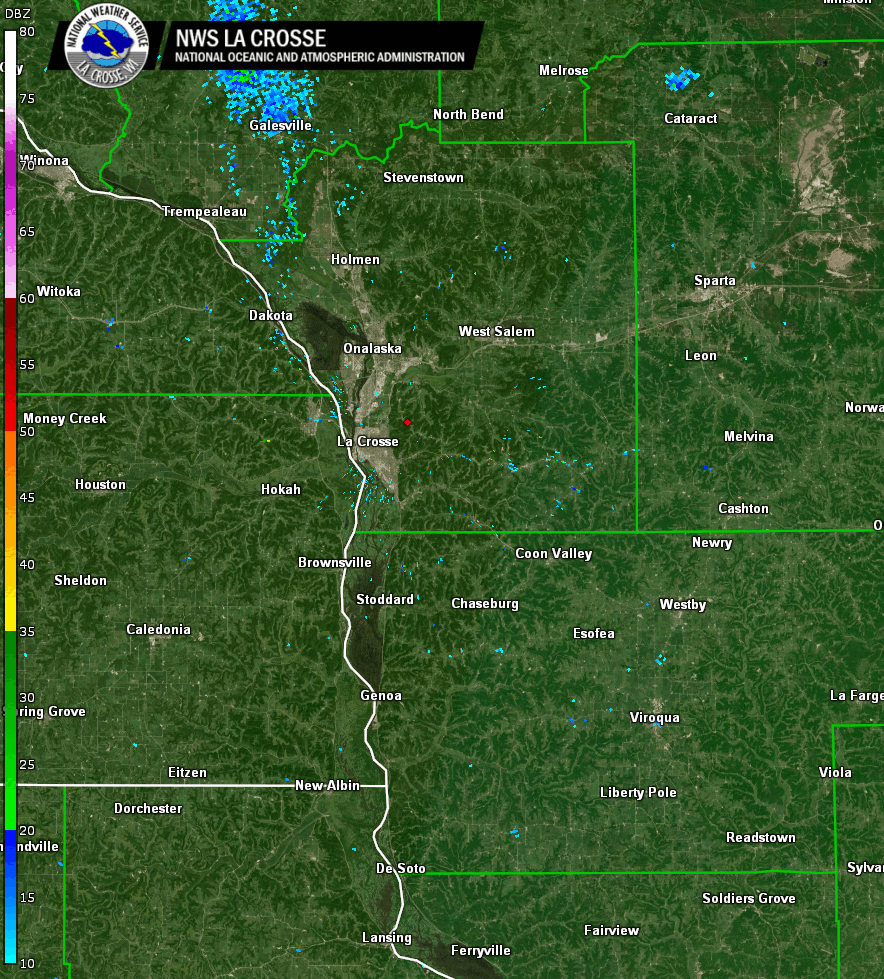 |
| Radar Imagery(La Crosse) June 1, 2023; 8:54pm-10:16pm |
 |
| Radar Imagery(La Crosse) June 3, 2023; 8:58pm-10:15pm |
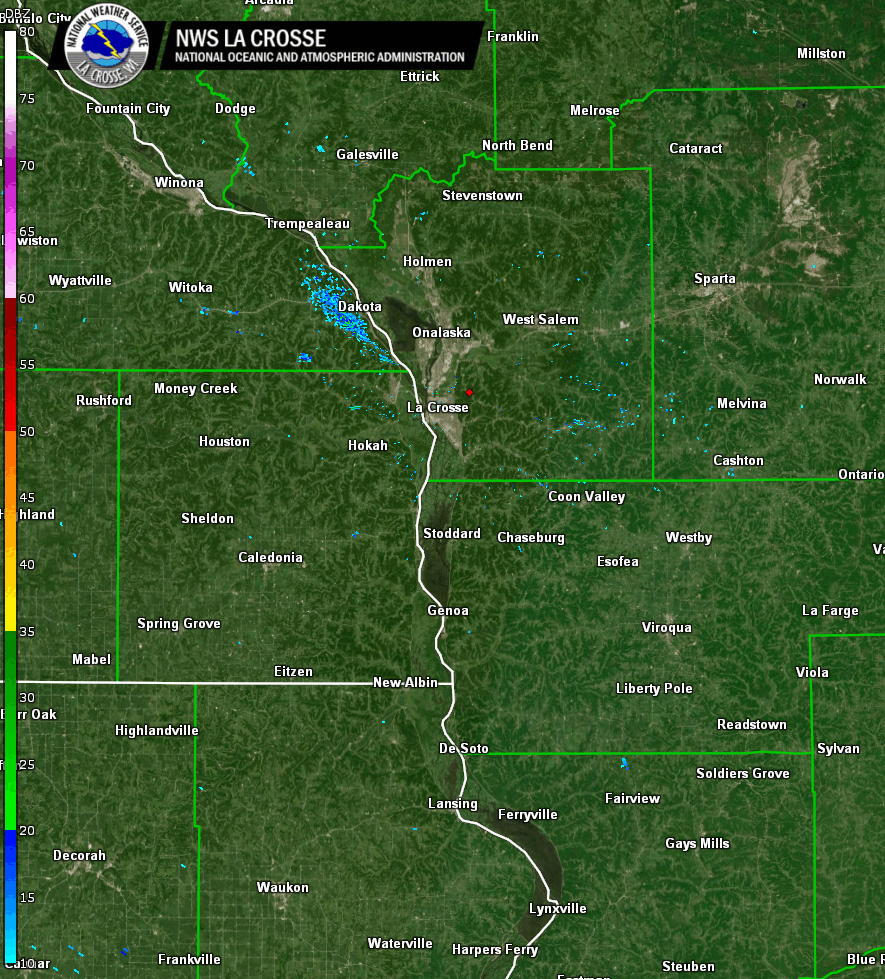 |
| Radar Imagery(La Crosse) >June 4, 2023; 8:16pm-10:11pm |
 |
| Radar Imagery(La Crosse) June 5, 2023; 8:29pm-10:32pm |
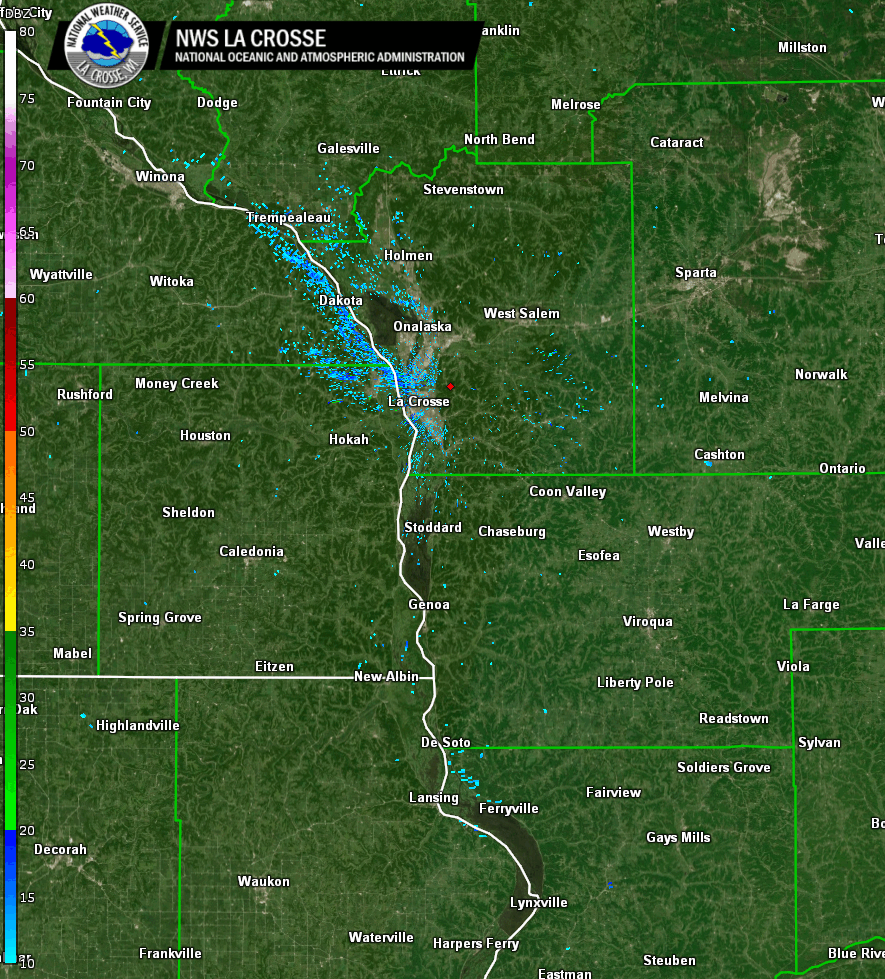 |
| Radar Imagery(La Crosse) June 6, 2023; 8:55pm-10:23pm |
 |
| Radar Imagery(La Crosse) June 7, 2023; 8:49pm-10:26pm |
 |
| Radar Imagery(La Crosse) June 8, 2023; 8:44pm-10:50pm |
Upper Mississippi Moderate Mayfly Emergence
July 1, 2023
A larger, moderate mayfly emergence was evident on the Upper Mississippi River from La Crosse, WI (top image) at the beginning of July, extending from near Prairie Du Chien, Wisconsin to Winona, Minnesota. Neighboring radars in Davenport, IA (middle image) and Chanhassen, MN (bottom image) also witnessed some of the hatch along the Mississippi as well as other local rivers. From Davenport's radar, besides the more obvious initial larger bloom along the Mississippi, smaller blooms were seen along the Wapsipinicon River to the north of the radar as well as potentially the Rock River east of the radar. Incoming storms south and west of Davenport's radar quickly resulted in a more noisy radar image, limiting our emergence investigation time. From the Chanhassen radar, an initial intense bloom was seen along the Mississippi River near Spring Lake northwest of Hastings. Shortly thereafter, the Minnesota River east and southwest of the radar showed hints of a bloom that may have lasted a couple of hours with light northerly winds sustaining bugs within and along the southwestern arm.
 |
| Radar Imagery (La Crosse, WI) (July 1, 2023; 9:01pm-12:25am CDT) |
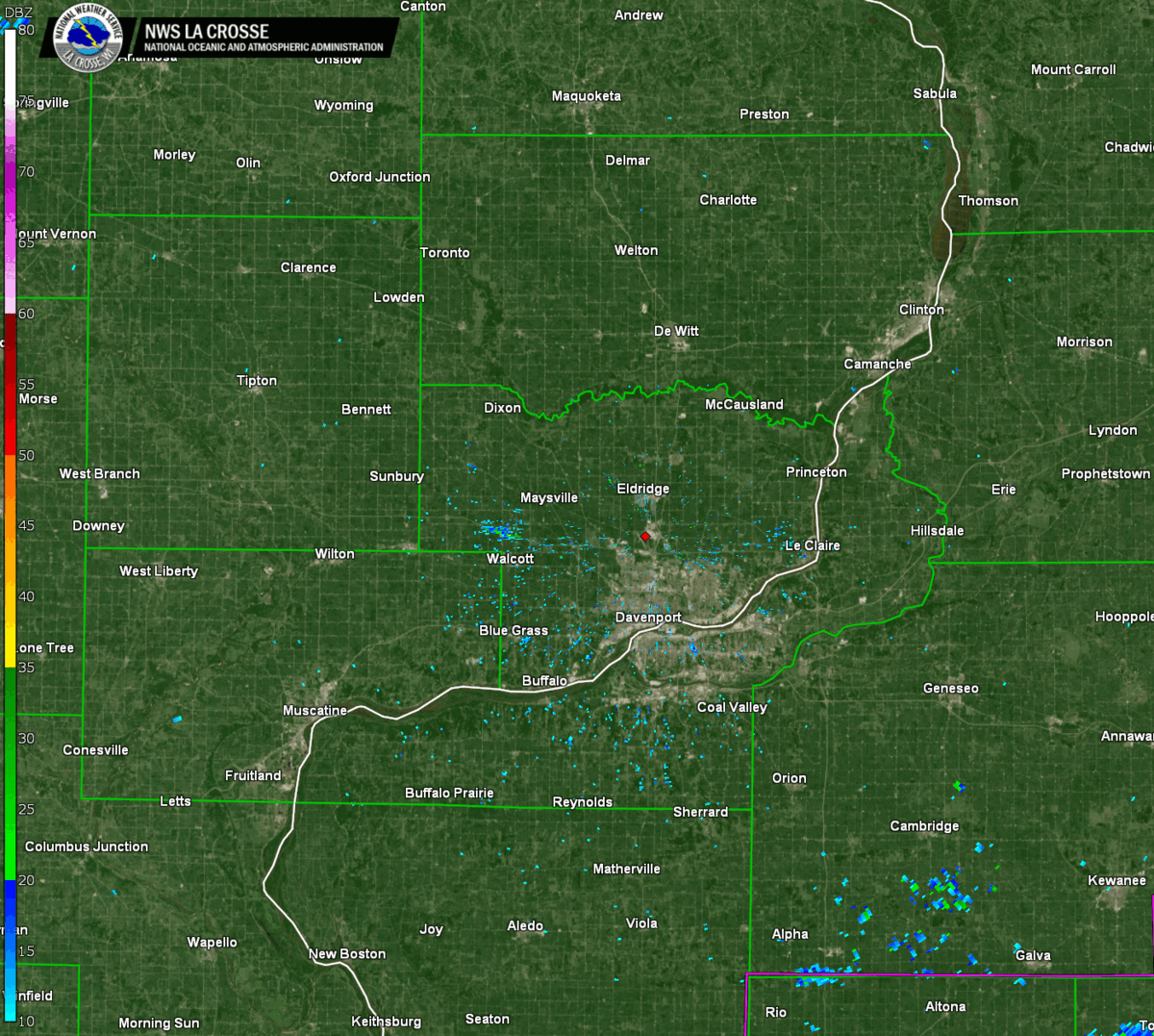 |
| Radar Imagery (Davenport, IA) (July 1, 2023; 8:47pm-9:399m CDT) |
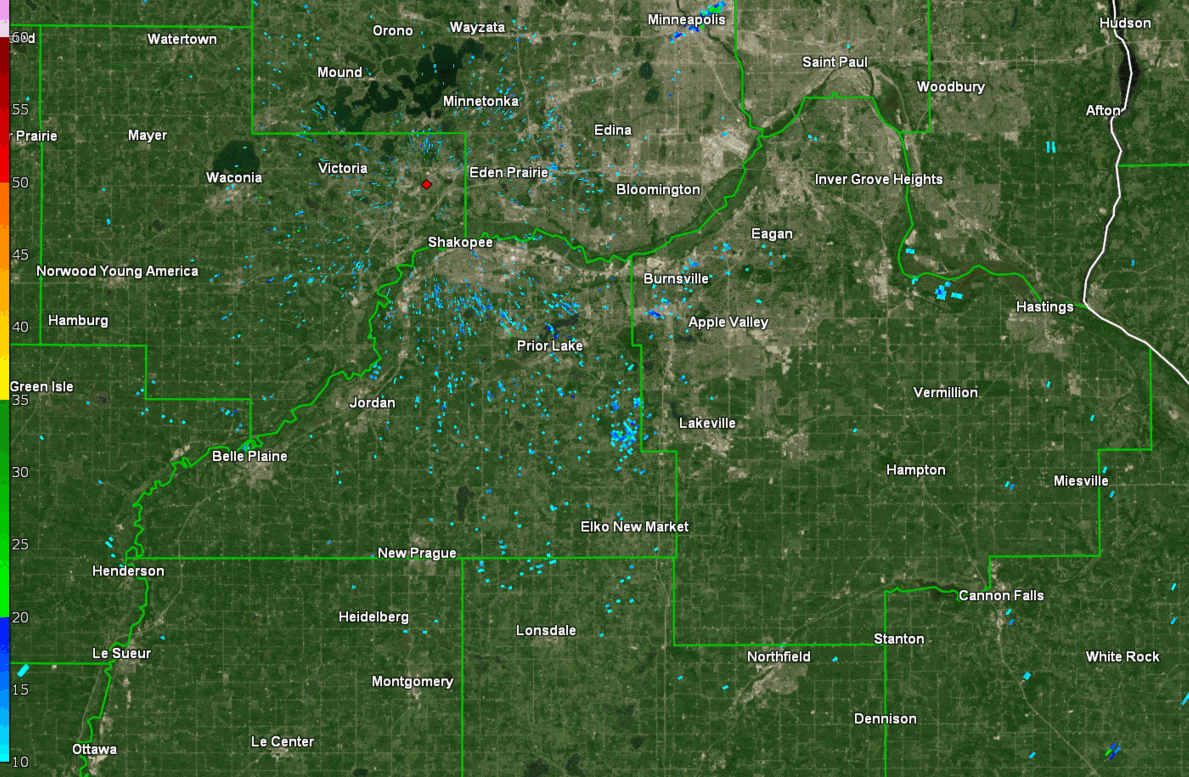 |
| Radar Imagery (Chanhassen, MN) (July 1, 2023; 9:19pm-2:51am CDT) |
Light Mayfly Emergence
August 1, 2023
 |
| La Crosse Radar Imagery (August 1, 2023; 9:19pm-11:56pm CDT) |
 |
 |
 |
|
| Mayfly crowding leftover light on brick in south La Crosse (Credit: Joseph Ricciotti; taken August 2nd at 6:30am) |
Hexagenia limbata Species (Credit: Joseph Ricciotti; taken August 2nd at 6:30am) |
Mayfly crowding leftover light and warmth on siding in South La Crosse (Credit: Joseph Ricciotti; taken August 2nd at 6:30am) |
Light Mayfly Emergence
August 3, 2023
 |
| La Crosse Radar Imagery (August 3, 2023; 8:53pm-10:15pm CDT) |
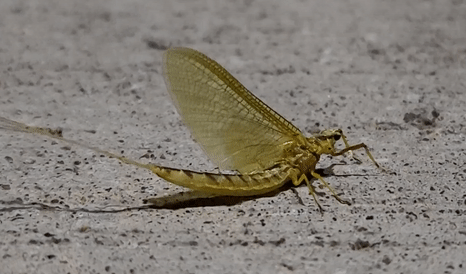 |
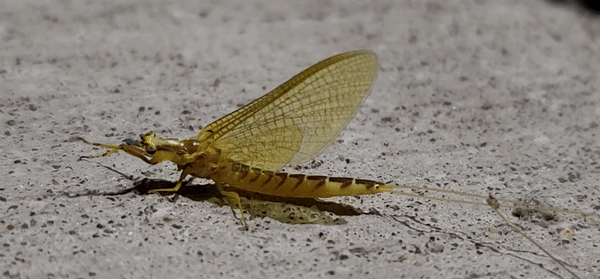 |
|
| A Mayfly strutting their stuff across the well lit sidewalk (Credit: Joseph Ricciotti; taken August 3rd at 10:15pm) |
A Mayfly strutting their stuff across the well lit sidewalk (Credit: Joseph Ricciotti; taken August 3rd at 10:15pm) |
 |
|
| Mayfly swarming street lights on the southside of La Crosse (Credit: Joseph Ricciotti; taken August 3rd at 10:15pm) |
 |
 |
 |
|
| Looking up a street pole of Mayflies basking in the light (Credit: Joseph Ricciotti) |
A dog laying amongst many Mayflies dotting the concrete sidewalk (Credit: Joseph Ricciotti) |
A dog curious as to the smell of a Mayfly (Credit: Joseph Ricciotti) |